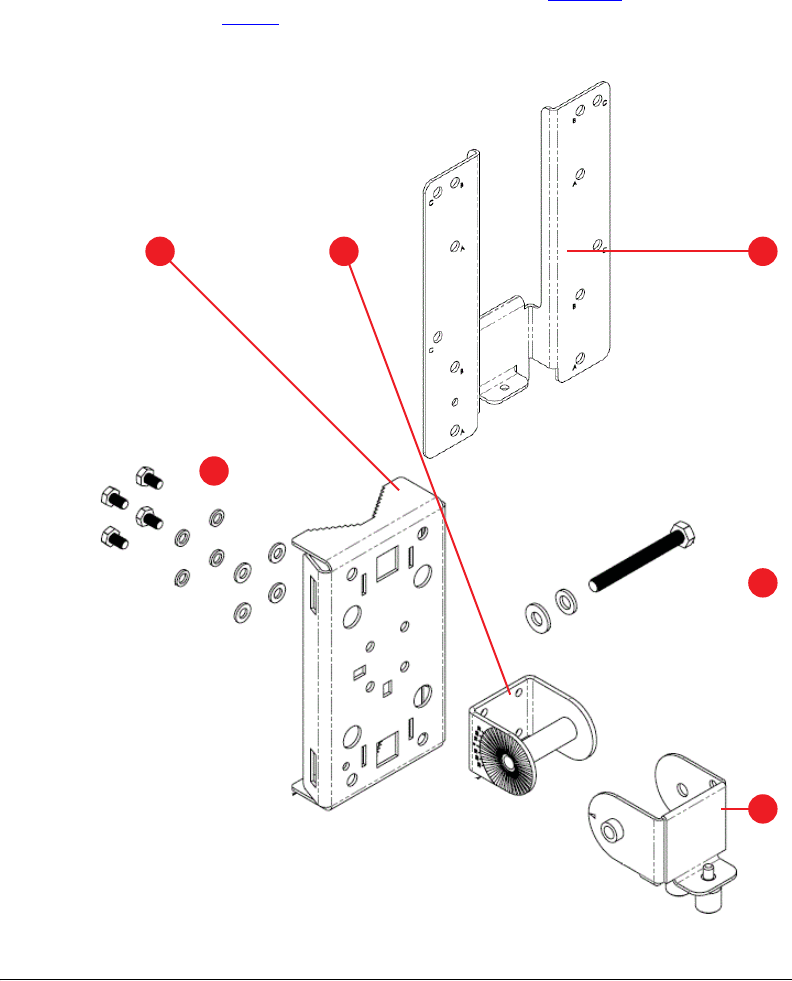Ruckus Wireless SC8800 IEEE 802.11 a/b/g/n Access Point User Manual Installation Guide
Ruckus Wireless, Inc. IEEE 802.11 a/b/g/n Access Point Installation Guide
Contents
- 1. Installation Guide
- 2. Regulatory Flyer
Installation Guide

Ruckus Wireless™
ZoneFlex™ SmartCell™ 8800
(SC8800-S) Outdoor Access Point
Installation Guid e
Part Number 800-70420-001 Re v B
Publishe d Ap ril 2013
www.ruckuswirele ss.co m

i
1About this Installation Guide . . . . . . . . . . . . . . . . . . . . . . . . . . . . . . . . . . . . . . . . . . . . . . . . . 1
Using this Installation Guide . . . . . . . . . . . . . . . . . . . . . . . . . . . . . . . . . . . . . . . . . . . . . . . 1
Related Documentation . . . . . . . . . . . . . . . . . . . . . . . . . . . . . . . . . . . . . . . . . . . . . . . . . . . 3
Documentation Feedback . . . . . . . . . . . . . . . . . . . . . . . . . . . . . . . . . . . . . . . . . . . . . . . . . 3
2Planning the SC8800-S AP Installation . . . . . . . . . . . . . . . . . . . . . . . . . . . . . . . . . . . . . . . . . 4
About the AP . . . . . . . . . . . . . . . . . . . . . . . . . . . . . . . . . . . . . . . . . . . . . . . . . . . . . . . . . . . . 4
AP Connectors and LEDs . . . . . . . . . . . . . . . . . . . . . . . . . . . . . . . . . . . . . . . . . . . . . . . . . . 6
Pointing the Internal GPS Antenna . . . . . . . . . . . . . . . . . . . . . . . . . . . . . . . . . . . . . . . . . 10
Performing a Site Survey . . . . . . . . . . . . . . . . . . . . . . . . . . . . . . . . . . . . . . . . . . . . . . . . . 11
Planning the Physical Installation . . . . . . . . . . . . . . . . . . . . . . . . . . . . . . . . . . . . . . . . . . . 12
Notes on Power Sources . . . . . . . . . . . . . . . . . . . . . . . . . . . . . . . . . . . . . . . . . . . . . . . . 12
Deciding How to Power the AP . . . . . . . . . . . . . . . . . . . . . . . . . . . . . . . . . . . . . . . . . . . 12
3Preparing the SC8800-S AP at the Depot and Shipping to the Field . . . . . . . . . . . . . . . . 13
Unpacking the AP . . . . . . . . . . . . . . . . . . . . . . . . . . . . . . . . . . . . . . . . . . . . . . . . . . . . . . . 13
Package Contents . . . . . . . . . . . . . . . . . . . . . . . . . . . . . . . . . . . . . . . . . . . . . . . . . . . . . . 13
Mounting Kit Contents . . . . . . . . . . . . . . . . . . . . . . . . . . . . . . . . . . . . . . . . . . . . . . . . . . 14
Powering the AP . . . . . . . . . . . . . . . . . . . . . . . . . . . . . . . . . . . . . . . . . . . . . . . . . . . . . . . . 14
Checking LED Operation . . . . . . . . . . . . . . . . . . . . . . . . . . . . . . . . . . . . . . . . . . . . . . . . 14
Configuring the AP for Management by ZoneDirector . . . . . . . . . . . . . . . . . . . . . . . . . 15
Connecting the AP to ZoneDirector . . . . . . . . . . . . . . . . . . . . . . . . . . . . . . . . . . . . . . . 15
Verifying the AP Registration . . . . . . . . . . . . . . . . . . . . . . . . . . . . . . . . . . . . . . . . . . . . . 15
Configuring the AP for Management by FlexMaster or for Standalone Operation . . 17
Configuring the Administrative Computer . . . . . . . . . . . . . . . . . . . . . . . . . . . . . . . . . . 17
Connecting the AP to the Administrative Computer . . . . . . . . . . . . . . . . . . . . . . . . . 19
Logging In to the Access Point’s Web Interface . . . . . . . . . . . . . . . . . . . . . . . . . . . . . 19
Configuring Common Wireless Settings . . . . . . . . . . . . . . . . . . . . . . . . . . . . . . . . . . . 20
Configuring Wireless # Settings . . . . . . . . . . . . . . . . . . . . . . . . . . . . . . . . . . . . . . . . . . 22
(Optional) Setting the FlexMaster Server Address . . . . . . . . . . . . . . . . . . . . . . . . . . . 23
Contents

ii
Verifying AP Operation . . . . . . . . . . . . . . . . . . . . . . . . . . . . . . . . . . . . . . . . . . . . . . . . . . . 25
Connecting the AP to the Network . . . . . . . . . . . . . . . . . . . . . . . . . . . . . . . . . . . . . . . . 25
Associating a Wireless Client with the AP . . . . . . . . . . . . . . . . . . . . . . . . . . . . . . . . . . 26
Checking the TR069 Status (FlexMaster Management Only) . . . . . . . . . . . . . . . . . . . 26
Disconnecting the AP from the Power Source and the Network . . . . . . . . . . . . . . . . 27
Disconnecting the AP from the Administrative Computer . . . . . . . . . . . . . . . . . . . . . 27
Restoring the Administrative Computer’s Network Settings . . . . . . . . . . . . . . . . . . . 27
Shipping the AP to the Field . . . . . . . . . . . . . . . . . . . . . . . . . . . . . . . . . . . . . . . . . . . . . . 28
4Installing the SC8800-S AP in the Field . . . . . . . . . . . . . . . . . . . . . . . . . . . . . . . . . . . . . . . . 29
Installation Components and Constraints . . . . . . . . . . . . . . . . . . . . . . . . . . . . . . . . . . . 29
Deploying the Access Point . . . . . . . . . . . . . . . . . . . . . . . . . . . . . . . . . . . . . . . . . . . . . . . 32
Connecting and Sealing the RJ-45 Cables . . . . . . . . . . . . . . . . . . . . . . . . . . . . . . . . . . 33
Preparing the Power Connections . . . . . . . . . . . . . . . . . . . . . . . . . . . . . . . . . . . . . . . . 34
Mounting the Access Point . . . . . . . . . . . . . . . . . . . . . . . . . . . . . . . . . . . . . . . . . . . . . . . 37
Mounting the U-Joint Bracket to the Main Mounting Bracket . . . . . . . . . . . . . . . . . . 39
Attaching the Main Mounting Bracket to a Flat Surface . . . . . . . . . . . . . . . . . . . . . . . 39
Attaching the Main Mounting Bracket to a Wooden Pole . . . . . . . . . . . . . . . . . . . . . 40
Attaching the Main Mounting Bracket to a Metal Pole . . . . . . . . . . . . . . . . . . . . . . . . 42
Mounting the Hook Bracket to the U-Joint Bracket . . . . . . . . . . . . . . . . . . . . . . . . . . 43
Assembling the AP Attachment Bracket and the Access Point . . . . . . . . . . . . . . . . . 44
Attaching the AP Attachment Bracket and AP to the Hook Bracket . . . . . . . . . . . . . 45
Safety-Cabling the AP . . . . . . . . . . . . . . . . . . . . . . . . . . . . . . . . . . . . . . . . . . . . . . . . . . 46
Mounting External Antennas (Optional) . . . . . . . . . . . . . . . . . . . . . . . . . . . . . . . . . . . . 48
Verifying Access Point Operation . . . . . . . . . . . . . . . . . . . . . . . . . . . . . . . . . . . . . . . . . . 50
Powering the AP . . . . . . . . . . . . . . . . . . . . . . . . . . . . . . . . . . . . . . . . . . . . . . . . . . . . . . . 50
Connecting the AP to the Network . . . . . . . . . . . . . . . . . . . . . . . . . . . . . . . . . . . . . . . . 53
Configuring the External Antenna Gain . . . . . . . . . . . . . . . . . . . . . . . . . . . . . . . . . . . . 54
Associating a Wireless Client with the AP . . . . . . . . . . . . . . . . . . . . . . . . . . . . . . . . . . 59
Checking the TR069 Status (FlexMaster Management only) . . . . . . . . . . . . . . . . . . . 59
5What to Do Next . . . . . . . . . . . . . . . . . . . . . . . . . . . . . . . . . . . . . . . . . . . . . . . . . . . . . . . . . . 60
Changing the Administrative Password . . . . . . . . . . . . . . . . . . . . . . . . . . . . . . . . . . . . . 60
Configuring the Security Settings . . . . . . . . . . . . . . . . . . . . . . . . . . . . . . . . . . . . . . . . . . 60
Configuring Advanced Settings and Features . . . . . . . . . . . . . . . . . . . . . . . . . . . . . . . . 60
Reading Related Documentation . . . . . . . . . . . . . . . . . . . . . . . . . . . . . . . . . . . . . . . . . . 60

iii
Appendix A: Ruckus Wireless-Supplied and Customer-Ordered Parts . . . . . . . . . . . . . . . . . 61
Appendix B: Resetting the Access Point to Factory Default Settings . . . . . . . . . . . . . . . . . . 65
Appendix C: Installer Mounting Dimensions . . . . . . . . . . . . . . . . . . . . . . . . . . . . . . . . . . . . . . 66

iv
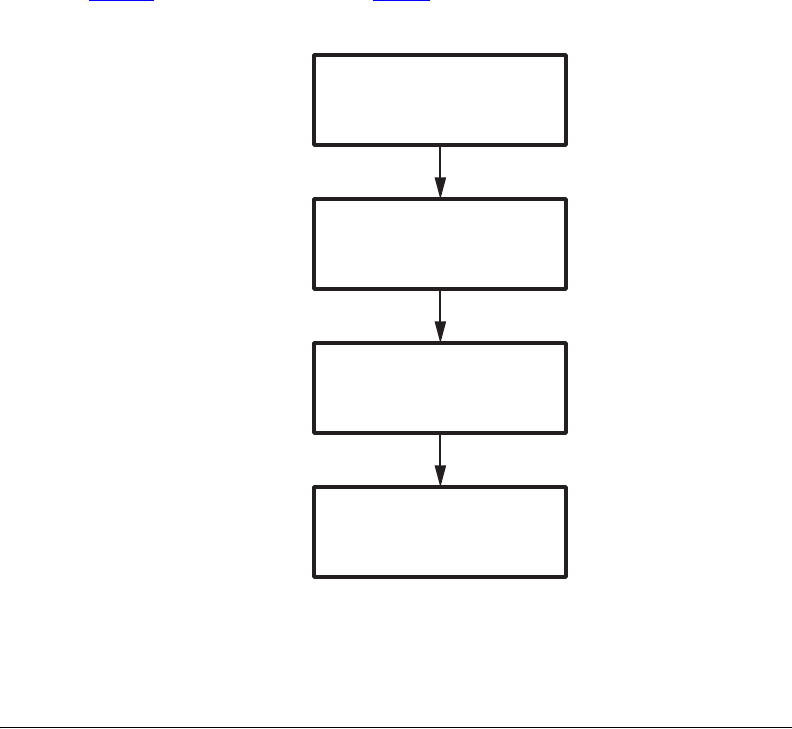
1
1About this Installation Guide
This Installation Guide provides information on how to add the Ruckus WirelessTM Smart-
Cell™ 8800 Access Point (SC8800-S AP, or AP) to your Ruckus Wireless network. Topics
covered in this guide include installing, basic configuring, and device mounting.
This guide is intended for use by those responsible for installing and setting up network
equipment. Consequently, it assumes a basic working knowledge of local area networking,
wireless networking, and wireless devices.
Using this Installation Guide
The AP installation is completed with four main steps. Each step includes some substeps.
Figure 1 shows the main steps, and Tab l e 1 includes the substeps.
Figure 1. Adding an SC8800-S AP to an existing Ruckus Wireless network flowchart
Planning
the Installation
Preparing at the Depot
and Sending to the Field
Installing the
SC8800-S in the Field
What to Do
Next

2
About this Installation Guide
Using this Installation Guide
NOTE: The AP can be managed using an AP web browser interface, an AP command line
interface (CLI), and using a simple network management protocol (SNMP) interface, such
as Ruckus Wireless ZoneDirectorTM or FlexMasterTM. This document contains configuring
instructions using these interfaces, as appropriate.
Table 1. Adding an SC8800-S AP to an Existing Ruckus Wireless network
Section Heading
2Planning the SC8800-S AP Installation
• About the AP
• AP Connectors and LEDs
• Pointing the Internal GPS Antenna
• Performing a Site Survey
• Planning the Physical Installation
3Preparing the SC8800-S AP at the Depot and Shipping to the Field
• Unpacking the AP
• Powering the AP
• Configuring the AP for Management by ZoneDirector
• Configuring the AP for Management by FlexMaster or for Standalone
Operation
• Verifying AP Operation
• Shipping the AP to the Field
4Installing the SC8800-S AP in the Field
• Installation Components and Constraints
• Deploying the AP
• Mounting the AP
• Verifying AP Operation
5What to Do Next
• Changing the Administrative Password
• Configuring the Security Settings
• Configuring Advanced Settings and Features
• Reading Related Documentation

3
About this Installation Guide
Related Documentation
Related Documentation
In addition to this guide, each Ruckus Wireless SC8800-S AP documentation set includes
the following:
■User Guide: Provides detailed information on how to configure the AP. The ZoneFlex
Outdoor AP User Guide is available for download on the Ruckus Wireless Support Web
site at
https://support.ruckuswireless.com/documents
(login required)
■Release Notes: Provides late-breaking information about the current software release,
including new features, enhancements, and known issues. If the information in the
Release Notes differs from the information in this guide, follow the instructions in the
Release Notes.
■Online Help: Accessible from the AP’s web interface, the Online Help provides
information that helps you configure the device from the web interface.
Documentation Feedback
Ruckus Wireless is interested in improving its documentation and welcomes your
comments and suggestions. You can email your comments to Ruckus Wireless at
docs@ruckuswireless.com
When contacting us, please include the following information:
■Document title
■Document part number (on the cover page)
■Page number (if appropriate)
For example:
■ZoneFlex SmartCell SC8800-S Outdoor Access Point Installation Guide
■Part number: 800-70420-001 Rev B
■Page 29
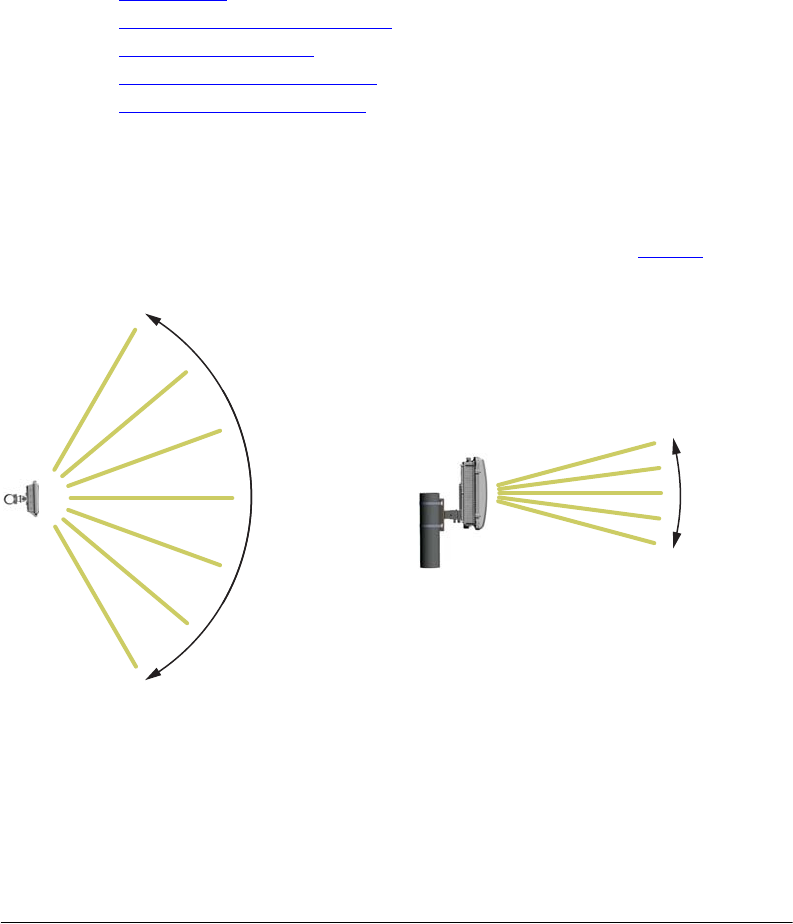
4
Planning the SC8800-S AP Installation
About the AP
2Planning the SC8800-S AP Installation
Before installing the SC8800-S AP, it is helpful to verify the version and to plan the AP
installation:
■About the AP
■Pointing the Internal GPS Antenna
■Performing a Site Survey
■Planning the Physical Installation
■Deciding How to Power the AP
About the AP
The AP is equipped with 120-Degree Sector 2.4GHz and 5GHz internal antennas, and these
antennas can be deployed where 2.4GHz and 5GHz horizontal beamforming can provide
extended reach and throughput to a 120-degree coverage area. See Figure 2.
Figure 2. Internal antenna 120-Degree sector coverage
Extended
120º Reach
Azimuth Plane Coverage, Top View
Extended
30º Vertical
Beamwidth
Elevation Plane Coverage
, Side View
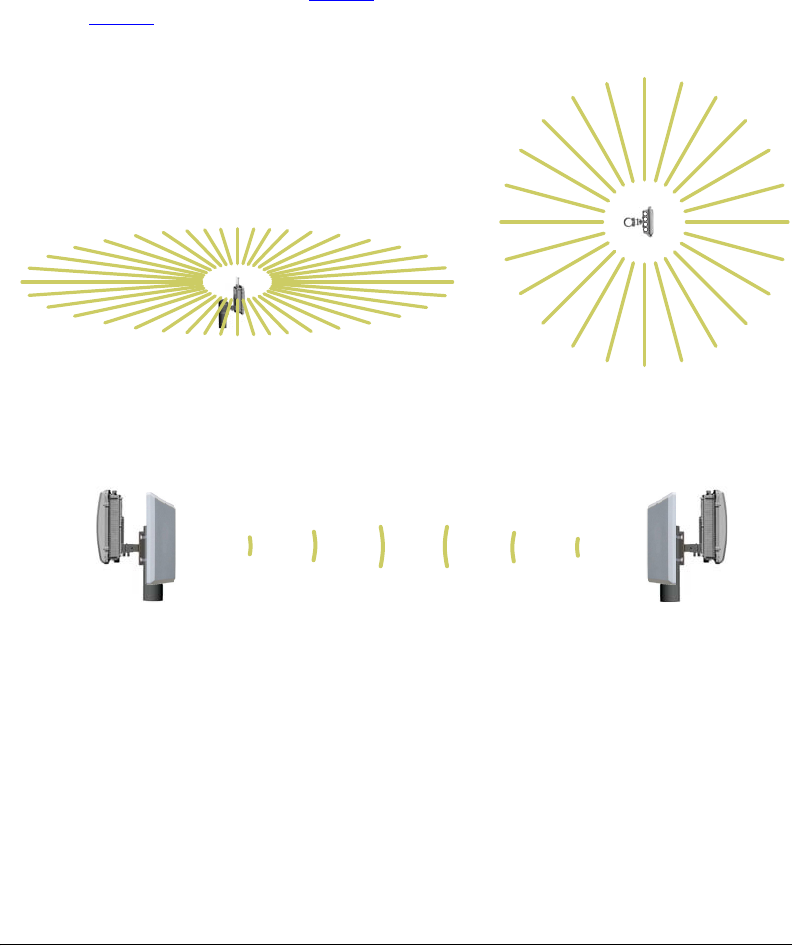
5
Planning the SC8800-S AP Installation
About the AP
The AP is equipped with two 5GHz N-type connectors, which allow operators to use up
to two customer-supplied external 5GHz antennas instead of the internal 5GHz antennas.
These external antennas can support operator-defined coverage areas and point-to-point
deployments. For instance, Figure 3 shows an AP used with omni external antennas, and
Figure 4 shows two APs used in a point-to-point backhaul deployment.
Figure 3. Typical AP omni deployment with an external antenna
Figure 4. Typical AP long-range point-to-point deployment with external antennas
Good Reach
Excellent
Reach
Excellent
Reach
Elevation Plane Coverage, Side View
Azimuth Plane Coverage, Top View
SC8800-S
Panel
Antenna
SC8800-S
Panel
Antenna
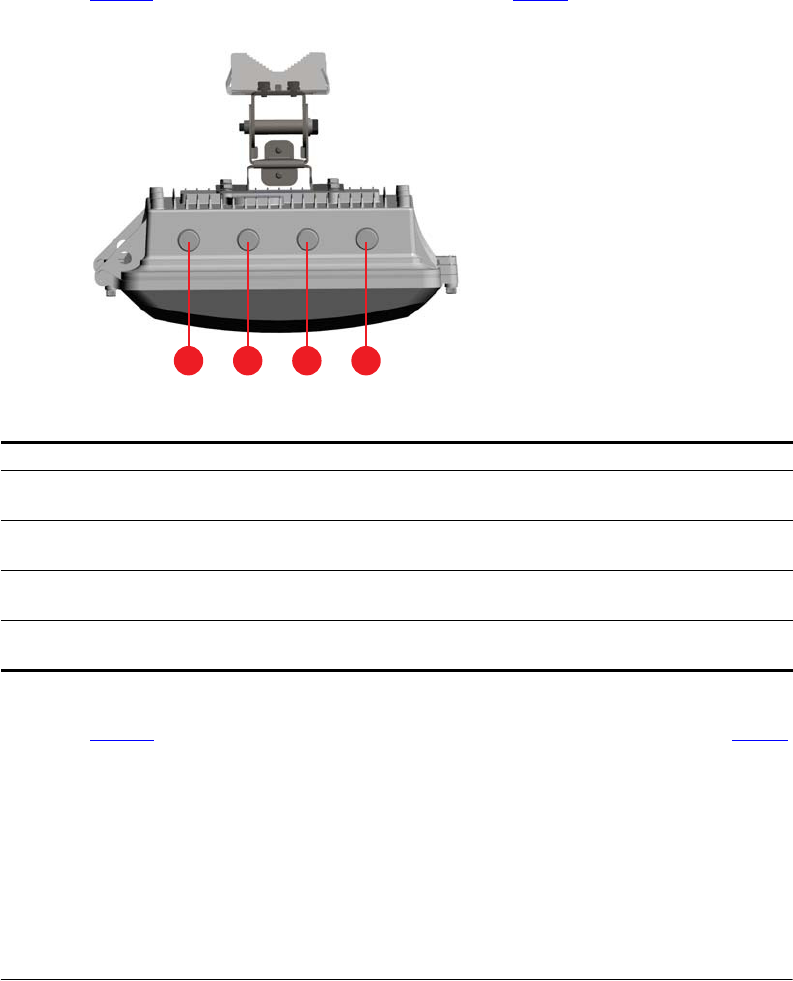
6
Planning the SC8800-S AP Installation
AP Connectors and LEDs
AP Connectors and LEDs
Figure 5 identifies the top-panel connectors on the AP. Tab l e 2 describes these connectors.
Figure 5. Top-panel connectors
Figure 6 identifies the AP bottom-panel connectors and LED locations on the AP. Tab l e 3
describes these connectors and LEDs.
1
23
4
Table 2. Top-panel connectors
No. Label Description
15GHz
ANT 0 port
5GHz 50-ohm N-type connector. Can be used with an external antenna for
operator-defined coverage areas and point-to-point deployments.
22.4GHz
ANT 2 port
2.4GHz 50-ohm N-type connector. Can be used with an external antenna for
operator-defined coverage areas and point-to-point deployments.
32.4GHz
ANT 0 port
2.4GHz 50-ohm N-type connector. Can be used with an external antenna for
operator-defined coverage areas and point-to-point deployments.
45GHz
ANT 2 port
5GHz 50-ohm N-type connector. Can be used with an external antenna for
operator-defined coverage areas and point-to-point deployments.
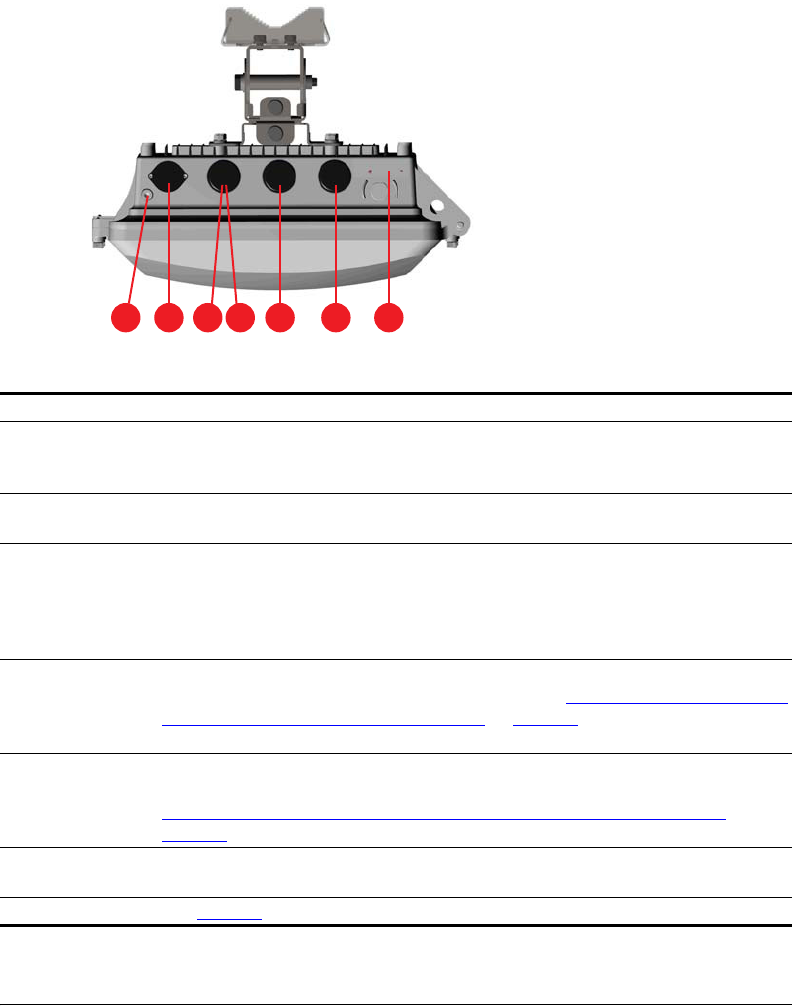
7
Planning the SC8800-S AP Installation
AP Connectors and LEDs
Figure 6. Bottom-panel connectors and LED locations
1 2 3 45 6 7
Table 3. Bottom-panel connectors
No. Label Description
1Earth
ground
screw
Use this screw to attach an earth ground to the AP as required by local
regulations.
2AC power
connector
You can use AC to supply power to the AP, in addition to using PoE.
3PoE OUT
RJ45 data
connector
Supports 10/100/1000Mbps connections and PoE out. If the AP is powered using
AC or the Ruckus Wireless PoE injector (ordered separately), then this port can
supply 802.3af (15.4W) PoE to a connected PoE-capable device (for example, an
IP-based surveillance camera). This port alternatively can supply 802.3at (25.5W)
PoE when used with 20m (65.6 ft.) or shorter CAT5e UTP or better cable.
4RESET
button
This button resets the AP to its factory defaults, and is mounted under the
RESET/PoE OUT RJ-45 waterproof gland. Refer to “ Appendix B: Resetting the
Access Point to Factory Default Settings” on page 65 to access the reset button
and reset the AP.
5PoE IN
RJ45 data
connector
Supports 10/100/1000Mbps connections, connects to the network and receives
Power over Ethernet (PoE) from the Ruckus Wireless 60W PoE injector. (Refer to
“ Appendix A: Ruckus Wireless-Supplied and Customer-Ordered Parts” on
page 61 to order a Ruckus Wireless 60W PoE injector.)
6FIBER port This waterproof gland allows you to run a fiber-optic cable into the SC8800-S
chassis to an optional fiber modem.
7LEDs See Figure 7.
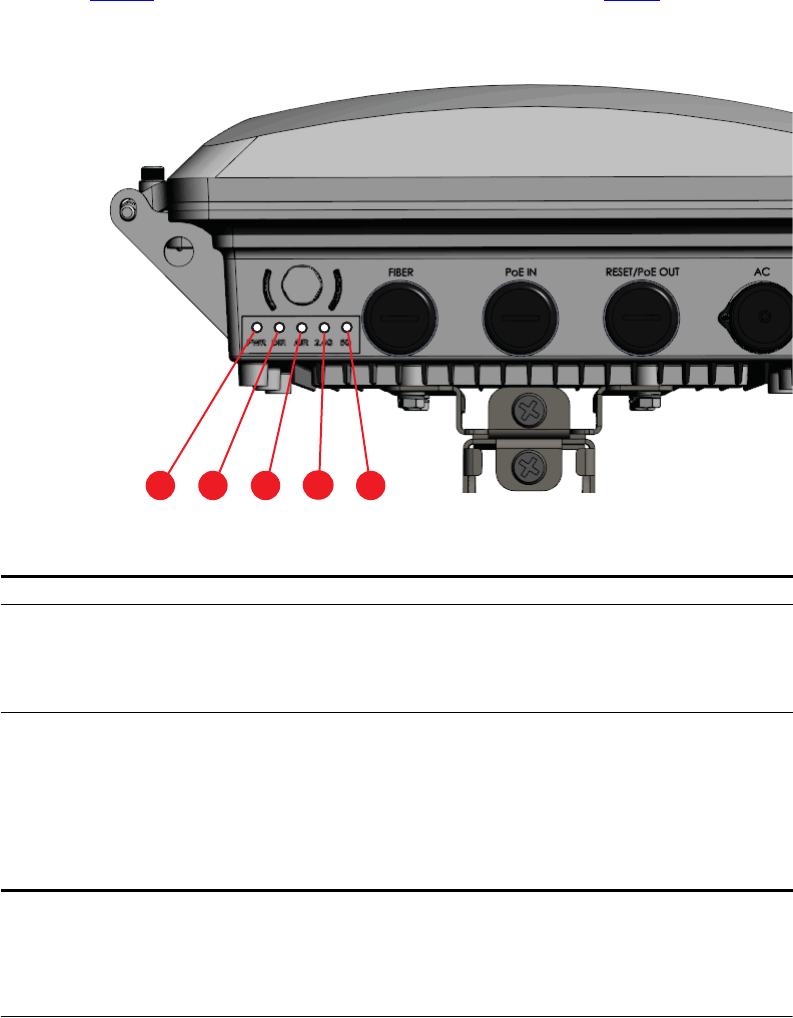
8
Planning the SC8800-S AP Installation
AP Connectors and LEDs
Figure 7 identifies the AP bottom-panel LED locations on the AP. Tab l e 4 describes these
connectors and LEDs.
Figure 7. LEDs
123
4
5
Table 4. LED descriptions
No. Label Description
1PWR LED •Off: No power is available, or the AP is not connected to a power source.
•Solid Red: The AP is powering on.
•Solid Green: The AP is connected to a power source and has completed its
power-on sequence.
2DIR LED •Off: The AP is NOT managed by ZoneDirector (standalone mode).
•Solid Green: The AP is managed by ZoneDirector and connection to
ZoneDirector has been established.
•Fast Flashing Green (0.5Hz): The AP is managed by ZoneDirector and is
currently receiving configuration settings (provisioning) or a firmware update.
•Slow Flashing Green (2Hz): The AP is managed by ZoneDirector, but is
currently unable to communicate with ZoneDirector.

9
Planning the SC8800-S AP Installation
AP Connectors and LEDs
3AIR LED •Off: The AP is in standalone mode, or acting as a Root AP if in mesh mode.
•Solid Green: The AP is functioning as a Mesh AP (MAP) and the uplink signal
quality is good (> 24dBm).
•Fast Flashing Green (0.5Hz): The AP is functioning as a Mesh AP (MAP) and
the wireless signal to its uplink AP is fair.
•Slow Flashing Green (2Hz): The AP is in mesh mode, but the AP is still
searching for a mesh uplink.
42.4G LED •Off: WLAN service is down.
•Amber (Yellow): WLAN service is up but with no client connected.
•Solid Green: WLAN service is up with at least one client connected.
55G LED •Off: WLAN service is down.
•Amber (Yellow): WLAN service is up but with no clients or downlink MAPs
associated/connected.
•Solid Green: WLAN service is up with at least one client is associated. No
downlink MAPs are connected.
•Fast Flashing Green (0.5Hz): The WLAN is up, at least one downlink MAP is
connected, and at least one client is associated.
•Slow Flashing Green (2Hz): The WLAN is up and at least one downlink MAP
is connected. No clients are associated.
Table 4. LED descriptions (Continued)
No. Label Description
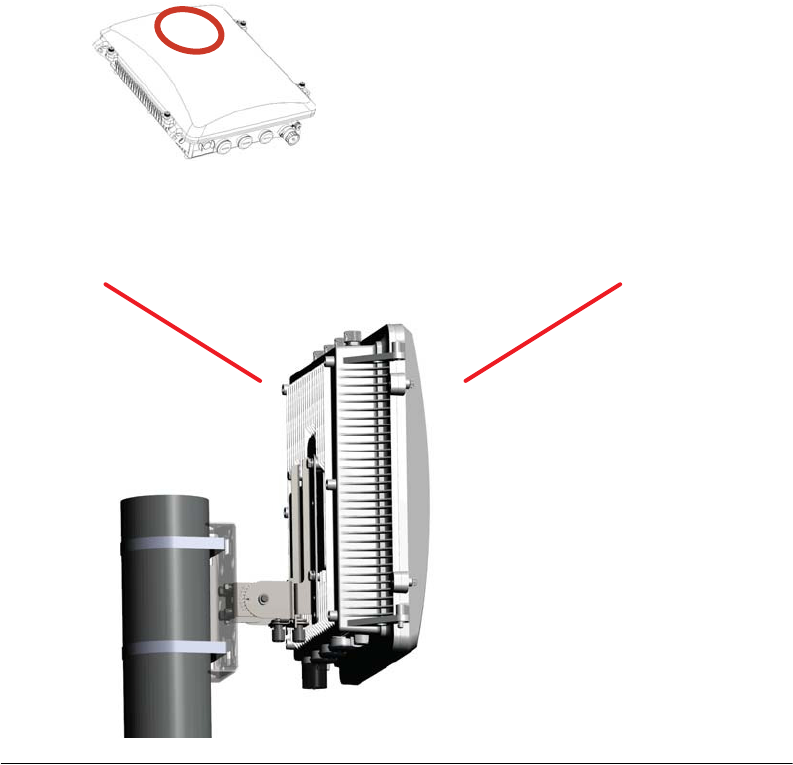
10
Planning the SC8800-S AP Installation
Pointing the Internal GPS Antenna
Pointing the Internal GPS Antenna
The AP includes an internal GPS antenna. When the AP is to be used with the optional
GPS feature enabled, the GPS antenna must be mounted outdoors and have as clear a
view of the sky as possible (as close as possible to 360 degrees, and with no obstructing
trees or buildings). The GPS antenna must not be installed where it can be covered with
snow buildup to avoid attenuating the GPS signal. These requirements must be met to
ensure that the GPS module can obtain lock and provide accurate GPS time and position.
If the GPS antenna has less than a clear 360-degree view of the sky, then the GPS module
may experience degraded performance.
Figure 8. GPS Antenna Location under Radome
Figure 9. Mounted GPS Antenna Position
Keep Clear
Sky View

11
Planning the SC8800-S AP Installation
Performing a Site Survey
Performing a Site Survey
Perform a site survey to determine the optimal AP placement or maximum range,
coverage, and network performance. Ruckus Wireless Support can supply Site Survey best
practices information.
The location and orientation that you choose for the AP play a critical role in the
performance of your wireless network. In general, Ruckus Wireless recommends installing
the AP away from obstructions and sources of interference and ensuring that the AP’s best
coverage zone (refer to “ About the AP” on page 4) is pointing in the general direction of
its wireless clients or associated bridge units.
When performing a site survey, consider the following factors:
■Data rates: Range is generally inversely proportional to data rates. The maximum radio
range is achieved at the lowest workable data rate. Higher data rates will generally be
achieved at closer distances.
■Antenna type and placement: Proper antenna configuration is a critical factor in
maximizing radio range. As a general rule, radio range is increased by mounting the
radio higher off of the ground with the AP oriented so that the dome is facing down
(for recommended orientation examples, refer to “ About the AP” on page 4).
■Physical environment: Clear or open areas provide better radio range than closed or
filled areas. The less cluttered the operating environment, the greater the wireless
range.
■Obstructions, building materials, and sources of interference: Physical obstructions,
such as concrete pillars, steel beams, filing cabinets, buildings and trees, can block or
hinder wireless communication. Avoid installing the AP in an environment where there
is an obstruction between sending and receiving devices. A number of machines and
electronic devices that emit radio waves, such as cranes, wireless phones, microwave
ovens, and satellite dishes, interfere with and block wireless signals. Building materials
used in construction also influence radio signal penetration. For example, drywall
construction permits greater range than concrete blocks.
■GPS Considerations: If the AP is to be used with the optional GPS feature enabled,
then the AP must be mounted outdoors and have as clear a view of the sky as possible
(as close as possible to 360 degrees) to help the GPS module obtain lock and provide
accurate GPS time and position. (Refer to “ Pointing the Internal GPS Antenna” on
page 10.) The GPS antenna must not be installed where it can be covered with snow
buildup to avoid attenuating the GPS signal. If the GPS antenna has less than a clear
360-degree view of the sky, then the GPS module may experience degraded perfor-
mance.

12
Planning the SC8800-S AP Installation
Planning the Physical Installation
Planning the Physical Installation
The AP can be installed indoors or outdoors, such as on an interior wall or ceiling, on the
exterior roof overhang of a building, or on a streetlight pole. The GPS antenna must be
installed outdoors for proper GPS operation.
Notes on Power Sources
■The AP only requires one power source (either AC or PoE), but can be powered by AC
and PoE at the same time.
■The AP may be powered by AC power or by PoE input using an Ruckus Wireless 60W
PoE injector (part number 902-0180-XX00, where XX is the country code).
■PoE OUT supports 802.3af (15.4W output) loads when the AP is operating off AC input
power or when operating off the PoE input port using a high-power 60W PoE Injector.
■When AC powered and PoE is present, the AP draws power from the AC connection.
■The AP PoE Output supports high power peripheral d evices up t o 25W, such as a sm all
cell or micro cell radio but only with the follow restrictions: the PoE Output cable length
between the AP and peripheral device is less than 8m (25 feet) and that the AP is
operating off of AC Input power. High-power peripherals (up to 25W) may also be
powered by an AP operating from the PoE Input using a high power 60W injector,
provided that the PoE input cable length between the injector and AP is less than 8m
(25 feet) and that the DC voltage at the AP PoE input connector is at least 44 VDC.
Deciding How to Power the AP
The AP can be powered using either AC power and/or Power over Ethernet (PoE). Use this
information and the information in “ Installation Components and Constraints” on page 29
to determine how to power the AP.
AC Power
Ruckus Wireless supplies an AC power cable connector with the AP. The customer supplies
the country-specific 3-wire AC power cable. The supported input voltages are 90-264 VAC
at 50/60Hz.
The APs used in a mesh network generally use AC power.
Power over Ethernet
The customer orders a Ruckus Wireless 60W PoE injector (part number 902-0180-XX00,
where XX is the country code).
The AP can be powered by 60W PoE to support 802.3at PoE Out to 27W. 802.3at (25.5W)
PoE can be supported with 8m (25 ft.) or shorter CAT5e UTP or better cable, and an 8m
(25 ft.) or shorter CAT5e UTP or better input cable. When AC powered and PoE is present,
the AP draws power from the AC connection.

13
Preparing the SC8800-S AP at the Depot and Shipping to the Field
Unpacking the AP
3Preparing the SC8800-S AP at the Depot
and Shipping to the Field
■Unpacking the AP
■AP Connectors and LEDs
■Powering the AP
■Configuring the AP for Management by ZoneDirector
■Configuring the AP for Management by FlexMaster or for Standalone Operation
■Verifying AP Operation
■Shipping the AP to the Field
Unpacking the AP
1. Open the ZoneFlex SC8800-S package, and then carefully remove the contents.
2. Return all packing materials to the shipping box, and put the box away in a dry location.
3. Verify that all items listed in “ Package Contents” and “ Mounting Kit Contents” are
included in the package. Check each item for damage. If any item is damaged or
missing, notify your authorized Ruckus Wireless sales representative.
NOTE: “ Appendix A: Ruckus Wireless-Supplied and Customer-Ordered Parts” on
page 61 includes pictures and descriptions of these and other factory-orderable and
customer-supplied parts.
Package Contents
A complete SC8800-S AP package contains all of the items listed below:
• SC8800-S Outdoor Access Point
• One AC power cable input end connector and cap
• Two M 25 data cable glands
• Service Level Agreement/Limited Warranty Statement
• Regulatory Statement
• Registration card
• Declaration of Conformity
• This Installation Guide
• Mounting kit (refer to “ Mounting Kit Contents” for details)

14
Preparing the SC8800-S AP at the Depot and Shipping to the Field
Powering the AP
Mounting Kit Contents
NOTE: “ Appendix A: Ruckus Wireless-Supplied and Customer-Ordered Parts” on
page 61 includes pictures and descriptions of these and other factory-orderable and
customer-supplied parts.
• Main mounting bracket (1 piece)
• U-Joint Bracket (1 piece)
• Small 10mm M6 x 1 Hex Bolt with Lock and Flat Washers (9 sets)
• Hook Bracket (1 piece)
• Large 70mm M8x1.25 hex bolt with spring lock and flat washers (1 set)
• AP Attachment Bracket (1 piece)
• SAE32 steel clamps, 2.5-inch diameter (4 pieces)
Powering the AP
NOTE: You only need to connect one type of power source at this point, even if you are
planning to use both PoE and AC power in your final deployment.
Apply power to the AP using one of these two methods:
•“ Powering the AP with AC” on page 51
•“ Powering the Access Point with PoE” on page 52
Checking LED Operation
Perform a spot-check using the LEDs to verify that the AP is operating normally. When the
AP is operating normally and no wireless clients are associated with it:
■The PWR LED is green.
■The 2.4G and 5G LED shows slow blinking green. This indicates that there are no
wireless clients connected to the AP’s WLAN services.
You have checked the LED operation. Continue with “ Configuring the AP for Management
by ZoneDirector” on page 15 or “ Configuring the AP for Management by FlexMaster or
for Standalone Operation” on page 17.

15
Preparing the SC8800-S AP at the Depot and Shipping to the Field
Configuring the AP for Management by ZoneDirector
Configuring the AP for M anagement by
ZoneDirector
1. Collect required equipment and information:
• One Cat5e or better Ethernet cable.
• MAC address (12 alphanumeric digits) from the outside of the AP case.
2. Verify that the AP is powered on as described in “ Powering the AP” on page 14.
Connecting the AP to ZoneDirector
NOTE: In addition to using Layer 2 auto discovery to enable the Access Point to register
with ZoneDirector, you can also use DHCP Option 43 or DNS. For more information, refer
to the ZoneDirector User Guide.
3. If you are powering the AP with PoE, then continue with Step 4. If you are powering
the AP with AC, then continue with Step 7.
4. Connect one end of the Ethernet cable to the Data In port on the PoE injector.
5. Connect the other end of the Ethernet cable to the same Layer 2 subnet as
ZoneDirector. The same Layer 2 subnet means that there should not be any router
between the AP and ZoneDirector.
The AP automatically discovers and registers with ZoneDirector.
6. You have completed connecting the AP to ZoneDirector. Continue with Step 10.
7. Connect one end of the Ethernet cable to the PoE IN port on the AP.
8. Connect the other end of the Ethernet cable to the same Layer 2 subnet as
ZoneDirector. The same Layer 2 subnet means that there should not be any router
between the AP and ZoneDirector.
The AP automatically discovers and registers with ZoneDirector.
9. You have completed connecting the AP to ZoneDirector. Continue with Step 10.
Verifying the AP Registration
10. Log in to ZoneDirector, and then go to the Monitor > Access Points page.
11. Look for the MAC address of the AP, and then in the Action column click the Allow
icon. This allows the AP to register with ZoneDirector.
When the Status column shows Connected, this indicates that the AP has successfully
registered with ZoneDirector.
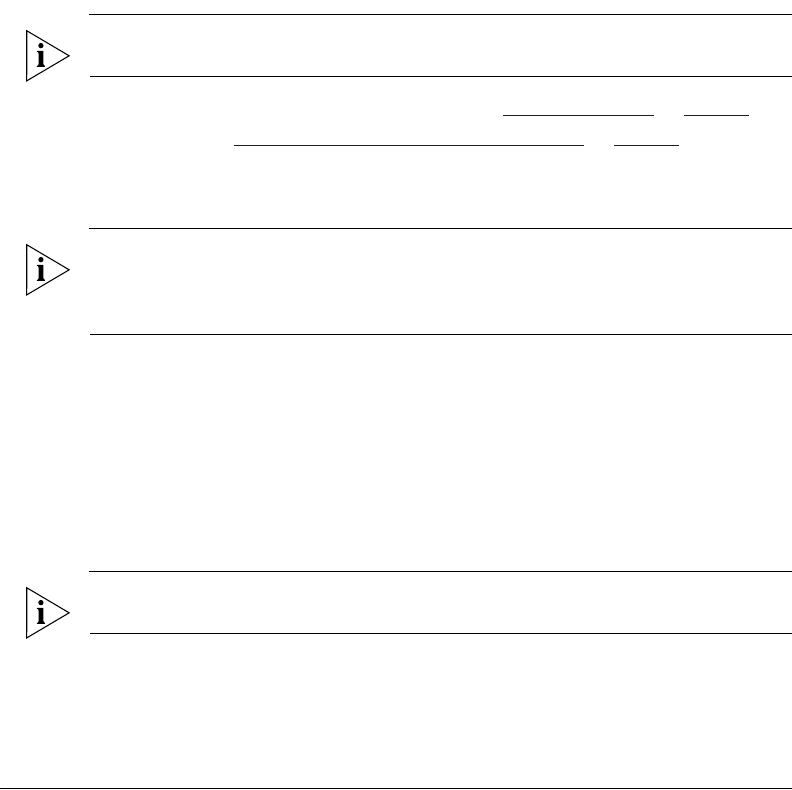
17
Preparing the SC8800-S AP at the Depot and Shipping to the Field
Configuring the AP for Management by FlexMaster or for Standalone Operation
Configuring the AP for M anagement by FlexMaster
or for Standalone Operation
1. Collect required equipment and information:
• An administrative computer (notebook computer) running Windows 7/Vista/XP/
2000 with one wireless 802.11b/g/n network card and one Ethernet card installed.
• Mozilla Firefox 2.0 (or later) or Microsoft Internet Explorer 6.0 (or later) installed on
the administrative computer.
• One Cat5e or better Ethernet cable.
• MAC address (12 alphanumeric digits) from the outside of the AP case.
NOTE: You may need to disable the firewall between the AP and the FlexMaster server
to complete this procedure.
2. Verify that the AP is powered on as described in “ Powering the AP” on page 14.
3. Continue with “ Configuring the Administrative Computer” on page 17.
Configuring the Administrative Computer
NOTE: The following procedure is applicable if the administrative computer is running
Windows XP or Windows 7. If you are using a different operating system, refer to the
documentation that was shipped with your operating system for information on how to
modify the computer’s IP address settings.
1. On your Windows 7 or Windows XP computer, open the Network Connections (or
Network and Dial-up Connections) control panel according to how the Start menu is
set up:
• On Windows 7, click Start > Control Panel > Network and Internet > Network
and Sharing Center > Change Adapter Settings.
• On Windows XP, click Start > Control Panel > Network Connections.
2. When the Network Connections window appears, right-click the icon for Local Area
Connection, and then click Properties.
NOTE: Make sure that you configure the Local Area Connection properties, not the
Wireless Network Connection properties.
3. When the Local Area Connection Properties dialog box appears, select Internet
Protocol (TCP/ IP) or TCP/ IPv4 in Windows 7 from the scrolling list, and then click
Properties. The Internet Protocol (TCP/IP) Properties dialog box appears.
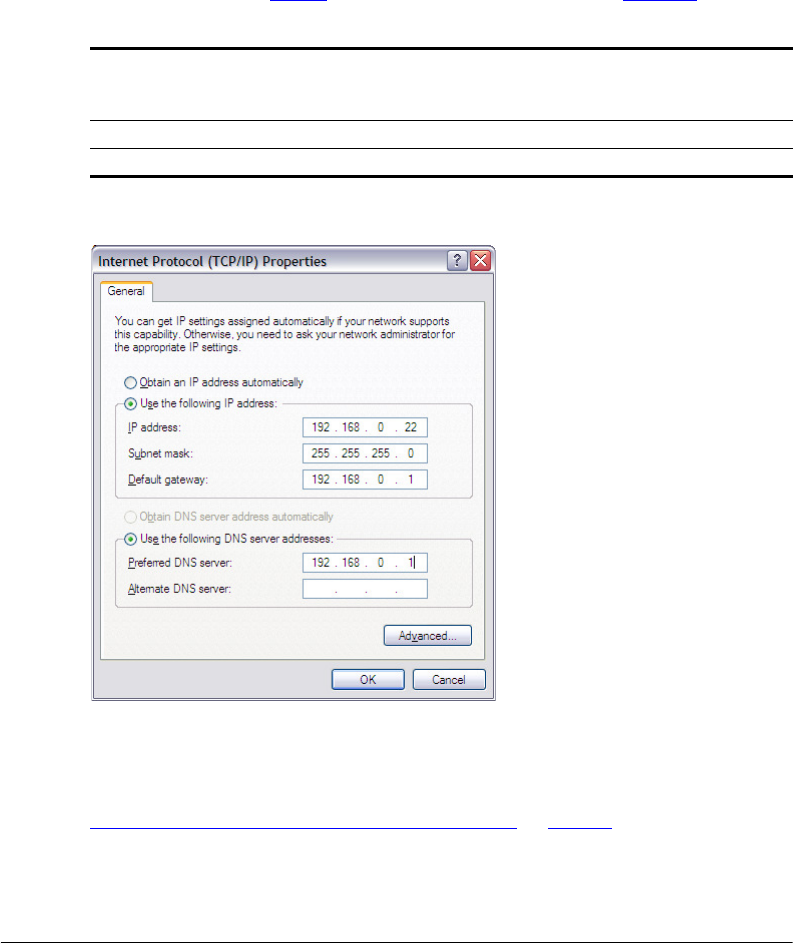
18
Preparing the SC8800-S AP at the Depot and Shipping to the Field
Configuring the AP for Management by FlexMaster or for Standalone Operation
4. Write down all of the currently active network settings. You will need this information
later when you restore your computer to its current network configuration.
5. Click Use the following IP address, and then configure the IP address settings with
the values listed in Tab l e 5. For a sample configuration, refer to Figure 10.
Figure 10. Sample configuration in the Internet Protocol (TCP/IP) Properties dialog box
6. Click OK to save your changes and close the TCP/IP Properties dialog box.
7. Click OK again to close the Local Area Connection Properties dialog box.
Windows saves the IP address settings that you have configured. Continue with
“ Connecting the AP to the Administrative Computer” on page 19.
Table 5. Configure your computer’s IP address settings
IP address 192.168.0.22 (or any address in the 192.168.0.x network—with the
exception of 192.168.0.1, which is the default IP address assigned to
the Access Point)
Subnet mask 255.255.255.0
Note: You can leave the Default Gateway and DNS server fields blank.

19
Preparing the SC8800-S AP at the Depot and Shipping to the Field
Configuring the AP for Management by FlexMaster or for Standalone Operation
Connecting the AP to the Administrative Computer
1. Verify that the AP is powered on as described in “ Powering the AP” on page 14.
2. If you are powering the AP with PoE, then continue with Step 3. If you are powering
the AP with AC, then continue with Step 6.
3. Connect one end of the Ethernet cable to the Data In port on the PoE injector.
4. Connect the other end of the Ethernet cable to the administrative computer either
directly or through a hub.
5. You have completed connecting the AP to the administrative computer. Continue with
“ Logging In to the Access Point’s Web Interface” on page 19.
6. Connect one end of the Ethernet cable to the PoE IN port on the AP.
7. Connect the other end of the Ethernet cable to the administrative computer.
8. You have completed connecting the AP to the administrative computer. Continue with
“ Logging In to the Access Point’s Web Interface” on page 19.
Logging In to the Access Point’s Web Interface
1. In the address or location bar, type the following address:
https://192.168.0.1
2. Press <Enter> on the keyboard to connect to the AP’s web interface. A security alert
message appears.
3. Click Ye s or OK or Proceed anyway (depending on the browser) to continue. The AP’s
login page appears.
Figure 11. The ZoneFlex Access Point login page
4. In Username, type super.
5. In Password, type sp-admin.
6. Click Login. The web interface appears, displaying the Status > Device page.
7. Continue with “ Configuring Common Wireless Settings” on page 20.
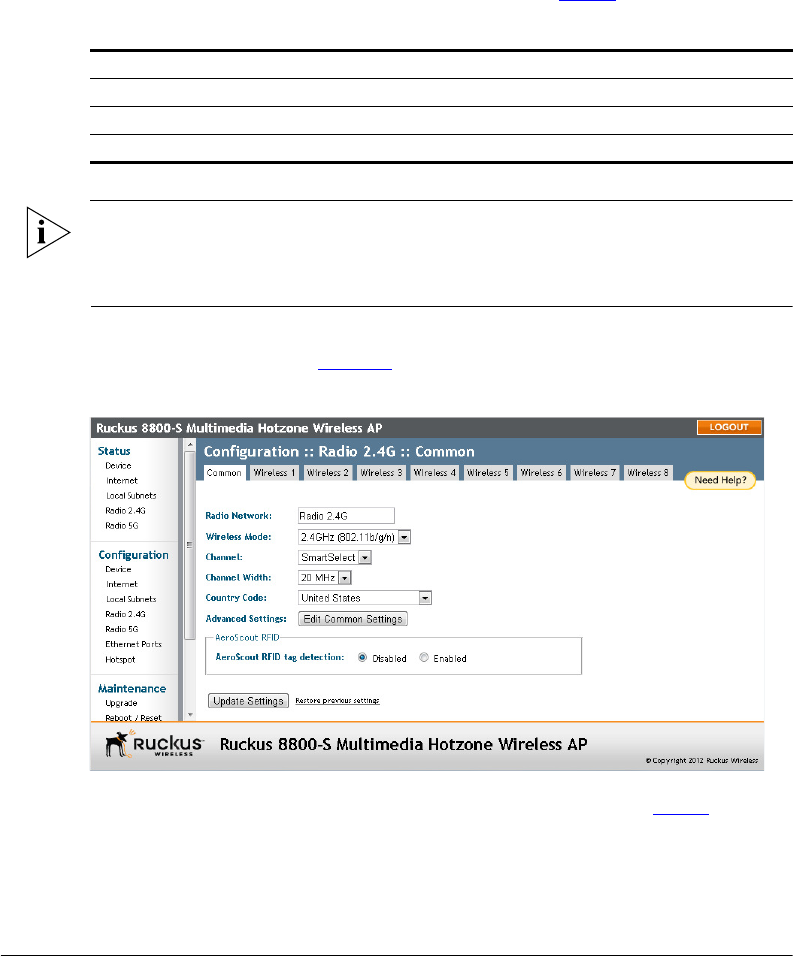
20
Preparing the SC8800-S AP at the Depot and Shipping to the Field
Configuring the AP for Management by FlexMaster or for Standalone Operation
Configuring Common Wireless Settings
The settings on the Common tab are required to enable wireless devices to associate with
the AP. The default wireless settings on the AP are listed in Tab l e 6.
NOTE: The AP has one 2.4GHz radio and one 5GHz radio. The wireless settings for each
radio need to be configured separately on the web interface. To configure the 2.4GHz
radio settings, click Configuration > Radio 2.4G. To configure the 5GHz radio settings,
click Configuration > Radio 5G.
1. On the left menu of the web interface, click Configuration > Radio {2.4/ 5} G. The
Common page appears (Figure 12).
Figure 12. The Configuration > Radio 2.4 > Common tab
2. Verify that the common wireless settings are configured as listed in Tab l e 7.
Table 6. Default wireless settings
Setting Default Value
SSID (network name) Wireless 1 to Wireless 8 (8 WLANs)
Encryption (security) Disabled on all WLANs
Default management IP address 192.168.0.1

21
Preparing the SC8800-S AP at the Depot and Shipping to the Field
Configuring the AP for Management by FlexMaster or for Standalone Operation
3. If you made any changes to the Common tab, then click Update Settings.
4. Continue with “ Configuring Wireless # Settings” on page 22.
Table 7. Common wireless configuration
Setting Recommended Value
Wireless Mode •2.4GHz (802.11b/g/n) for Configuration > Radio 2.4G > Common.
•5GHz (802.11a/ n) for Configuration > Radio 5G > Common.
Channel SmartSelect.
Channel Width 20 M Hz.
Country Code • If you purchased the AP in the United States, this value is fixed to
United States at the factory and is not user configurable.
• If you purchased the AP outside the United States, verify that the
value is set to your country or region. Selecting the correct country
code ensures that the AP uses only the radio channels allowed in
your country or region.
Note: The two radios on the ZoneFlex AP are always configured with
the same country code setting. If you change the country code for
Radio 2.4G, for example, the same change will be automatically
applied to Radio 5G.
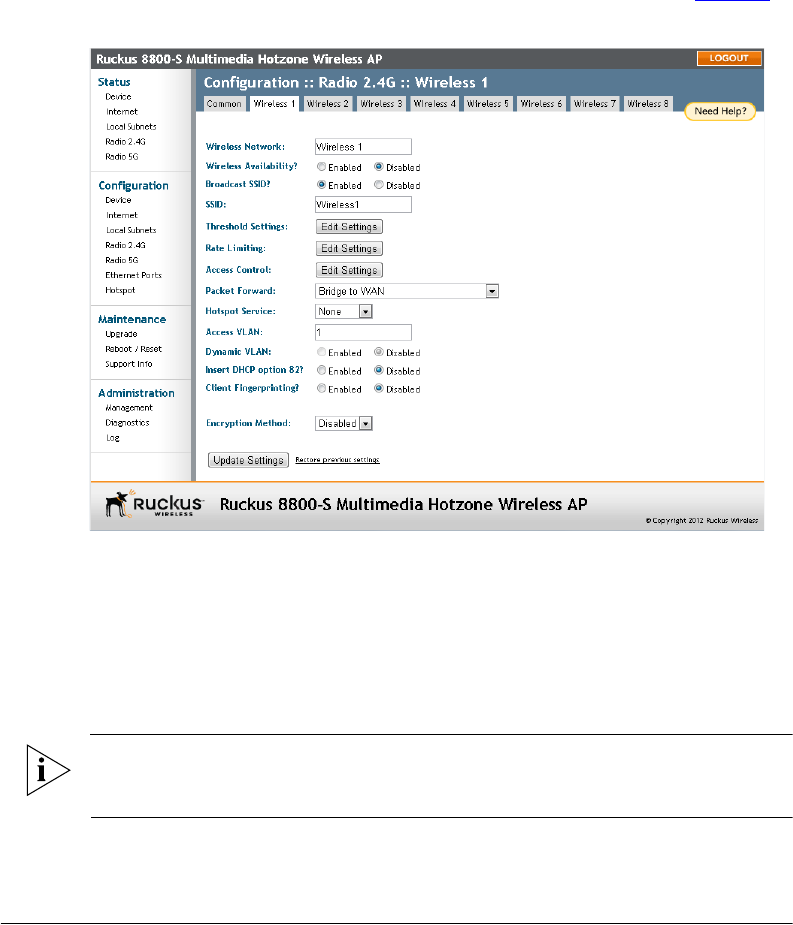
22
Preparing the SC8800-S AP at the Depot and Shipping to the Field
Configuring the AP for Management by FlexMaster or for Standalone Operation
Configuring Wireless # Settings
The settings on at least one Wireless # tab are required to enable wireless devices to
associate with the AP.
1. Click one of the Wireless # tabs. The selected Wireless # page appears (Figure 13).
Figure 13. The Configuration > Radio 2.4 > Wireless 1 tab
2. In Wireless Availability, click Enabled.
3. In Broadcast SSID, click Enabled.
4. Clear the SSID box, and then type a unique and descriptive name that you want to call
this wireless network.
For example, you can type Ruckus Wireless AP. This SSID is the name that helps
users identify this wireless network in their wireless network connection application.
NOTE: You may also configure other wireless settings on this and other Wireless # tabs
(in addition to the settings described above), although it is not necessary for completing
the AP installation.
5. Click Update Settings. You have completed configuring the basic wireless settings of
the AP.
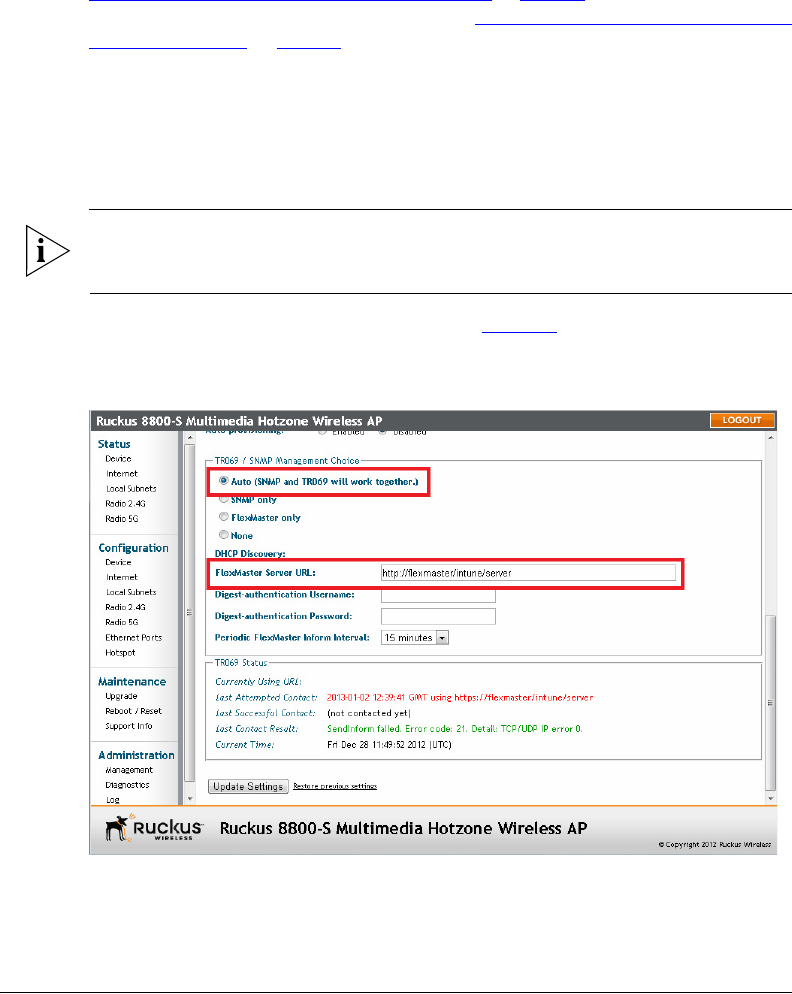
23
Preparing the SC8800-S AP at the Depot and Shipping to the Field
Configuring the AP for Management by FlexMaster or for Standalone Operation
If you are configuring the AP for management by FlexMaster, then continue with
“ (Optional) Setting the FlexMaster Server Address” on page 23. If you are configuring the
AP for standalone operation, then continue with “ Disconnecting the AP from the Admin-
istrative Computer” on page 27.
(Optional) Setting the FlexMaster Server Address
If you have a FlexMaster server installed on the network and you intend to use FlexMaster
to manage the AP, you can set the FlexMaster server address at this point. Before starting
this procedure, make sure you obtain the correct FlexMaster server URL.
NOTE: In addition to setting the FlexMaster server URL manually on the AP, you can also
use DHCP Option 43 or DNS to point the AP to the FlexMaster server. For more
information, refer to the FlexMaster User Guide.
1. Navigate to Administration > Management (Figure 14).
2. Scroll down the page to the TR069 / SNM P Management Choice section.
Figure 14. Type the FlexMaster server URL
3. Verify that the Auto option is selected.

24
Preparing the SC8800-S AP at the Depot and Shipping to the Field
Configuring the AP for Management by FlexMaster or for Standalone Operation
4. In FlexMaster Server URL, type the URL of the FlexMaster server on the network. You
can use either http or https to connect to the URL and include either the host name
or IP address of the FlexMaster server in the URL. The following are examples of valid
FlexMaster server URLs:
http://flexmaster/intune/server
https://flexmaster/intune/server
http://192.168.20.1/intune/server
https://192.168.20.1/intune/server
5. Click Update Settings to save your changes. You have completed setting the
FlexMaster server address on the AP.
NOTE: Instructions on how to verify that the AP and FlexMaster can communicate with
each other are provided in “ Checking the TR069 Status (FlexMaster Management Only)”
on page 26.
6. Continue with “ Verifying AP Operation” on page 25.

25
Preparing the SC8800-S AP at the Depot and Shipping to the Field
Verifying AP Operation
Verifying AP Operation
Ruckus Wireless recommends that you verify that the AP is operating correctly.
NOTE: You can perform these verification tasks indoors.
To verify that the AP is operating correctly, perform the following procedures:
■Connecting the AP to the Network
■Associating a Wireless Client with the AP
■Checking the TR069 Status (FlexMaster Management Only)
■Disconnecting the AP from the Power Source and the Network
■Disconnecting the AP from the Administrative Computer
■Restoring the Administrative Computer’s Network Settings
Connecting the AP to the Network
This procedure assumes that you have already assembled an AC cord connector as
described in “ Powering the AP with AC” on page 51, or that you have a Ruckus Wireless
60W PoE injector available as described in “ Powering the Access Point with PoE” on
page 52.
NOTE: You only need to connect one type of power source at this point, even if you are
planning to use both PoE and AC power in your final deployment.
The AP can connect to the network using data cables, or can connect to the network using
wireless backhaul if it is part of a mesh network.
NOTE: If the ZoneDirector is set to Enable Mesh, ZoneDirector automatically assigned
the AP as a Root AP while “ Configuring the AP for Management by ZoneDirector” on
page 15.
1. If the AP is part of an available mesh network, continue with Step 2. If the AP is using
AC power, then continue with Step 4. If the AP is using PoE, then continue with Step 6.
2. When the AP has been configured as Root AP, and is powered up and does not find a
wired connection back to its ZoneDirector, it automatically looks for another Root AP.
When it finds another AP in the mesh network, it automatically provisions itself as a
Mesh AP in the mesh network.
3. Continue with “ Associating a Wireless Client with the AP” on page 59.
4. Connect the Ethernet cable from your network’s router or switch to the PoE IN port on
the AP.

26
Preparing the SC8800-S AP at the Depot and Shipping to the Field
Verifying AP Operation
5. Continue with “ Associating a Wireless Client with the AP” on page 59.
6. Connect the Ethernet cable from the Data In port on the PoE injector to your network’s
router or switch.
7. Continue with “ Associating a Wireless Client with the AP” on page 59.
Associating a Wireless Client with the AP
1. In the client device's wireless interface, select the SSID configured in the “ Configuring
Wireless # Settings” on page 22 section.
2. Connect the client device to the selected WLAN SSID.
3. After the wireless client successfully connects to the wireless LAN, continue with
“ Checking the TR069 Status (FlexMaster Management Only)” on page 26 or
“ Disconnecting the AP from the Power Source and the Network” on page 27.
Checking the TR069 Status (FlexMaster M anagement
Only)
If you configured the AP to report to a FlexMaster server on the network (see “ (Optional)
Setting the FlexMaster Server Address” on page 23), then make sure you verify that the
AP can successfully communicate with the FlexMaster server. You can do this by checking
the TR069 status on the AP’s web interface.
1. In the AP’s web interface, go to the Administration > Management page.
2. Scroll down to the TR069 Status section.
3. Check the value for Last successful contact. If it shows a date in green, then the AP was
able to communicate successfully with FlexMaster.
4. Continue with “ Disconnecting the AP from the Power Source and the Network” on
page 27.

27
Preparing the SC8800-S AP at the Depot and Shipping to the Field
Verifying AP Operation
Disconnecting the AP from the Power Source and the
Network
1. Disconnect the AP from the power source (either from the PoE injector or AC power
source).
2. Verify that the PWR LED is off.
3. Disconnect the Ethernet cable that runs to the AP’s PoE IN RJ45 port from your
network’s router or switch.
4. Continue with “ Disconnecting the AP from the Administrative Computer” on page 27.
Disconnecting the AP from the Administrative Computer
1. If not already done, disconnect the AP from the power source (either from the AC
power source or PoE injector).
2. Verify that the PWR LED is off.
3. Disconnect the Ethernet cable from the administrative computer’s Ethernet port.
4. Continue with “ Restoring the Administrative Computer’s Network Settings” on
page 27.
Restoring the Administrative Computer’s Network
Settings
If the administrative computer’s network settings were changed as described in “ Config-
uring the Administrative Computer” on page 17 and you do not want to change the
network settings back now, then continue with “ Shipping the AP to the Field” on page 28.
If you do want to change the network settings back now, continue with the following steps:
NOTE: You may need to enable the firewall between the AP and the FlexMaster server
to complete this procedure.
1. On your Windows 7 or Windows XP computer, open the Network Connections (or
Network and Dial-up Connections) control panel according to how the Start menu is
set up:
• In Windows 7, click Start > Control Panel > Network and Internet > Network and
Sharing Center > Change adapter settings.
• In Windows XP, click Start > Control Panel > Network Connections.
2. When the Network Connections window appears, right-click the icon for Local Area
Connection, and then click Properties.

28
Preparing the SC8800-S AP at the Depot and Shipping to the Field
Shipping the AP to the Field
3. When the Local Area Connection Properties dialog box appears, select Internet
Protocol (TCP/ IP) from the scrolling list, and then click Properties. The TCP/IP
Properties dialog box appears.
4. Restore the computer’s network settings by typing the original IP address settings in
the TCP/IP Properties dialog box.
5. On the TCP/ IP Properties dialog box, click OK to close it.
6. Click OK again to close the Local Area Connection Properties dialog box.
You are now ready to ship the AP. Continue with “ Shipping the AP to the Field” on page 28.
Shipping the AP to the Field
After you have prepared the AP as described earlier in this section, repackage the AP and
its mounting kit in the original shipping container and ship it to its final installation site.
Continue with “ Installing the SC8800-S AP in the Field” on page 29.

29
Installing the SC8800-S AP in the Field
Installation Components and Constraints
4Installing the SC8800-S AP in the Field
Before installing the AP, Ruckus Wireless recommends that you first complete the proce-
dures described in “ Planning the SC8800-S AP Installation” on page 4 and “ Preparing the
SC8800-S AP at the Depot and Shipping to the Field” on page 13. Completing these
procedures ensures that the AP installation has been planned, and that the AP has been
prepared for installation.
Continue with the following procedures:
■Installation Components and Constraints
■Deploying the Access Point
■Mounting the Access Point
■Verifying Access Point Operation
Installation Components and Constraints
■The AP can be installed indoors or outdoors, such as on an interior wall or ceiling, on
the exterior roof overhang of a building, or on a streetlight pole.
■Refer to Figure 15 for the components involved in a typical outdoor PoE installation.
Refer to Figure 16 for the components involved in a typical outdoor AC installation.
Note which components must be installed indoors and outdoors.
■Ruckus Wireless strongly recommends 80mm - 130mm (3” -5” ) drip loops on any cables
that are installed outdoors (for example, on an outdoor AP).
■The AP can be powered using either AC power and/or Power over Ethernet (PoE).
•AC Power: An AC power cable connector is supplied with the AP. The customer
supplies the country-specific 3-wire AC power cable. The supported input voltages
are 90-264 VAC 50/ 60Hz.
•Power over Ethernet: The customer orders a Ruckus Wireless PoE injector (part
number 02-0180-XX00, where XX is the country code).
■The APs used in a mesh network generally use AC power.
NOTE: The AP only requires one power source (either AC or PoE, but can be powered
by AC and PoE at the same time.
- The AP can be powered by 60W PoE to support 802.3af PoE Out to 15.4W.
- The AP can be powered by 60W PoE to support 802.3at PoE Out to 27W. 802.3at (25.5W)
PoE can be supported with 20m (65.6 ft.) or shorter CAT5e UTP or better cable.
- When AC powered and PoE is present, the AP draws power from the AC connection.
WARNIN G: Only trained and qualified personnel should be allowed to install, replace,
or service this equipment.
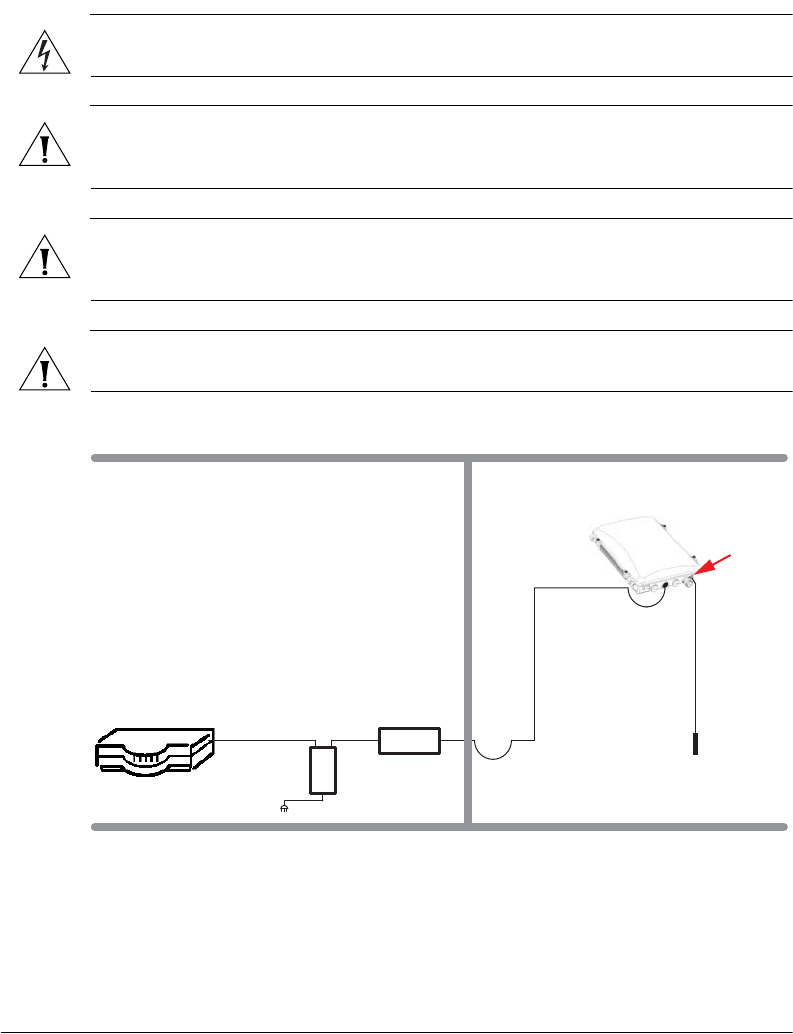
30
Installing the SC8800-S AP in the Field
Installation Components and Constraints
WARNIN G: Installation of this equipment must comply with local and national electrical
codes.
CAUTION: Make sure that you form a 80mm - 130mm (3” -5” ) drip loop in any cable that
is attached to the AP or the building. This will prevent water from running along the cable
and entering the AP or the building where the cable terminates.
CAUTION: Be sure that grounding is available and that it meets local and national
electrical codes. For additional lightning protection, use lightning rods and lightning
arrestors.
.
CAUTION: Make sure that proper lightning surge protection precautions are taken
according to local electrical code.
Figure 15. Typical outdoor PoE installation components
Indoor
Router
or switch Cat5 Ethernet
cables
Surge
protector
Outdoor
Drip
loop
Drip
loop
Ground
rod
Ground
screw
Outdoor-rated
Cat5e UTP cable
5.5mm2 (10AWG)
min solid-core wire
ZoneFlex
SC8800-S
Outdoor AP
AC cable
PoE
injector
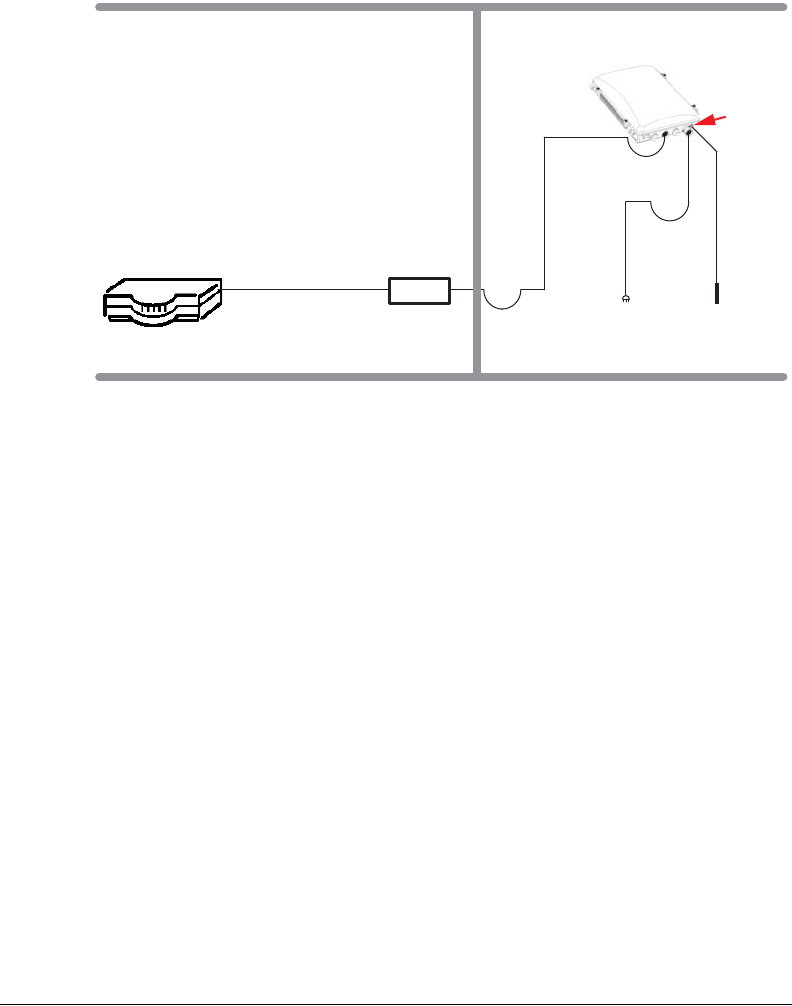
31
Installing the SC8800-S AP in the Field
Installation Components and Constraints
Figure 16. Typical outdoor AC installation components
Indoor
Router
or switch Cat5 Ethernet
cable
Surge
protector
Outdoor
Drip
loop
Drip
loops
AC power
source
Ground
rod
Ground
screw
Outdoor-rated
Cat5e UTP cable
5.5mm2 (10AWG)
min solid-core wire
AC cable
ZoneFlex
SC8800-S
Outdoor AP

32
Installing the SC8800-S AP in the Field
Deploying the Access Point
Deploying the Access Point
In this section, you will mount the AP in its final mounting location and verify its operation.
Perform the following:
■Connecting and Sealing the RJ-45 Cables
■Preparing the Power Connections
■Attaching the Main Mounting Bracket to a Flat Surface
■Attaching the Main Mounting Bracket to a Metal Pole
■Assembling the AP Attachment Bracket and the Access Point
■Attaching the AP Attachment Bracket and AP to the Hook Bracket
■Safety-Cabling the AP
■Mounting External Antennas (Optional)
■Powering the AP
■Connecting the AP to the Network
■Configuring the External Antenna Gain
■Associating a Wireless Client with the AP
■Checking the TR069 Status (FlexMaster Management only)
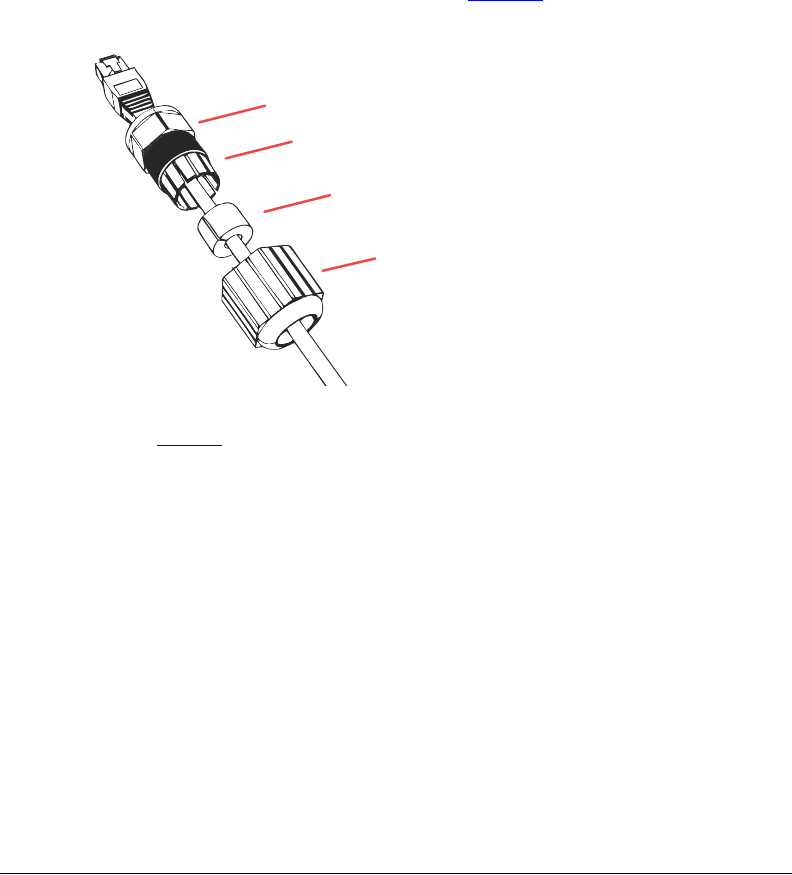
33
Installing the SC8800-S AP in the Field
Deploying the Access Point
Connecting and Sealing the RJ-45 Cables
The AP comes with two sets of waterproof RJ-45 cable glands. To complete this procedure,
you will need an RJ-45 cable and a cable gland.
1. Take out one of the plastic bags containing a cable gland.
2. Feed the end of the cable through the sealing nut, rubber O-ring, clamping ring
assembly and cable gland base as shown in Figure 17.
Figure 17. Cable and cable gland assembly
3. Remove the required (RESET/ PoE OUT or PoE IN) blanking cap from the SC8800-S.
(See Figure 6 for cap location.)
4. Connect the cable to the ethernet port in the SC8800-S.
5. Hand-tighten the cable gland base into the SC8800-S chassis.
6. Wrap the clamping ring assembly around the rubber O-ring. Make sure that the
clamping ring assembly fully encloses the rubber O-ring.
7. Seat the clamping ring assembly and rubber O-ring in the cable gland base.
8. Hand-tighten the sealing nut
You have completed connecting and sealing the cable. Repeat this procedure as required
for the other cables.
Cable gland base
Clamping ring assembly
Rubber O-ring
Sealing nut

34
Installing the SC8800-S AP in the Field
Deploying the Access Point
Preparing the Power Connections
The AP supports both AC power and PoE and it can be connected to both power sources
at the same time. If you want use both power sources, complete these power connections
using both of these two methods:
•Preparing the AC Power Connection
•Preparing the PoE Power Connection
Preparing the AC Power Connection
1. Collect required tools and supplies:
• An outdoor-rated three-wire (1-2mm2 or 14-18AWG) AC cable that is long enough
to connect the AP with the AC power source.
• A wire stripper.
• A pair of long-nose pliers.
• A small screwdriver.
• A ruler (for measuring the stripped portion of the AC cable).
2. Remove the small plastic bag that contains the AC cable connector from the AP
package.
3. Separate the AC cable connector parts by unscrewing the boot from the cable gland
and the cable gland from the connector housing. See Figure 18.
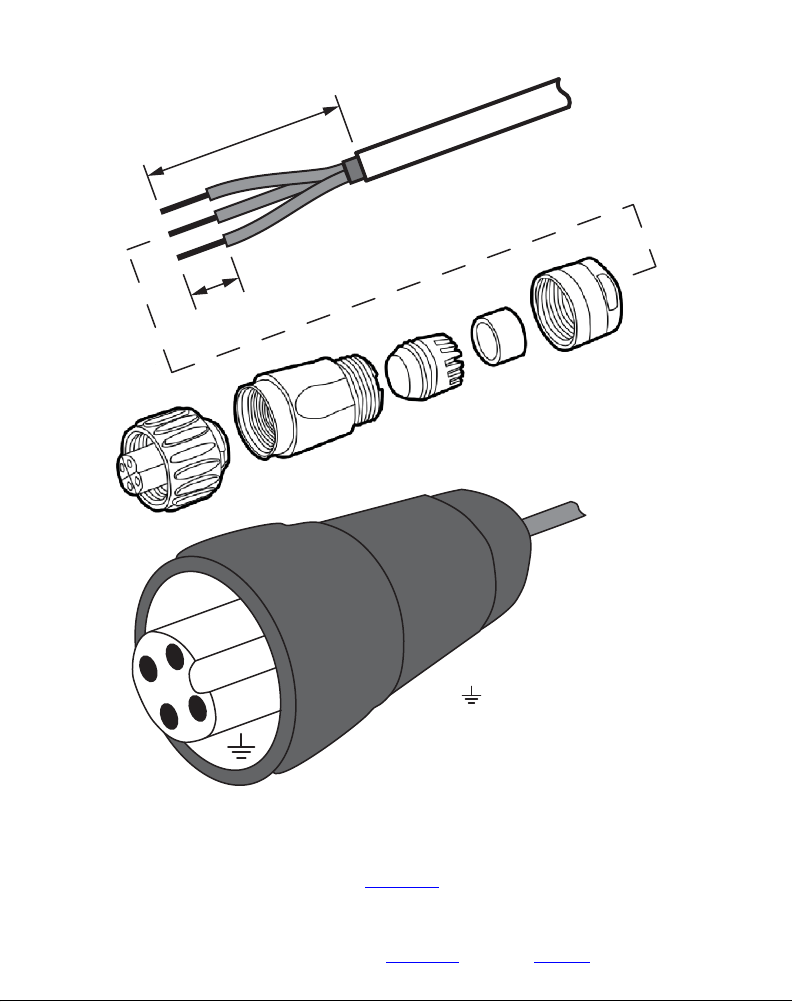
35
Installing the SC8800-S AP in the Field
Deploying the Access Point
Figure 18. Assembling the AC power connector
4. Feed the end of the AC cable through the boot and cable gland.
5. Strip the AC cable as shown in Figure 18.
6. Insert the stripped part of the conductors into the appropriate terminals on the
connector housing. The conductors are color-coded and must be connected to the
appropriate terminals as shown in Figure 18. Refer to Tab l e 8 for typical AC wire colors.
36mm or 1.42in (max)
9mm or 0.35in (max)
1
3
2
Earth Ground
Neutral/Return
Line/Hot
(not used)
1
3
2
Wire Stripping Drawn
Actual Size (1:1)

36
Installing the SC8800-S AP in the Field
Deploying the Access Point
7. Using a small screwdriver, tighten the small screws around the connector housing to
fix the connector pins into the terminals.
8. Mate the cable gland with the connector housing, and then tighten.
NOTE: Two different-sized grommets are supplied in the AC connector assembly kit. Use
the grommet that is appropriate to the diameter of the AC cable that you are using.
9. Mate the boot with the cable gland, and then tighten to seal.
10. Connect the AC cord connector that you have assembled to the AC power socket on
the AP.
WARNIN G: Do not apply power to the AP at this point. You should connect the AP to a
power source only after you finish connecting all other components included in “ Verifying
Access Point Operation” on page 50.
You have prepared the AC power connection.
Preparing the PoE Power Connection
1. Obtain a Ruckus Wireless 60W PoE injector. (Refer to “ Appendix A: Ruckus Wireless-
Supplied and Customer-Ordered Parts” on page 61 to order a Ruckus Wireless 60W
PoE injector.)
2. Obtain one outdoor-rated and one indoor-rated Cat5e or better Ethernet cable.
3. Connect one end of the outdoor-rated Ethernet cable to the Data Out/Power Out port
on the PoE injector, and then connect the other end to the PoE IN port on the AP.
WARNIN G: Do not apply power to the AP at this point. You should connect the AP to a
power source only after you finish connecting all other components in “ Verifying Access
Point Operation” on page 50.
You have prepared the PoE power connection.
Table 8. Typical AC wire colors
Terminal Color
(Earth Ground) Green (US), Green/Yellow (EU)
1 (Neutral/Return) White or Gray (US), Blue (EU)
2 (Line/Hot) Black (US), Brown (EU)
3 (not used)
Note: The color coding of wire conductors varies by region. Before completing this step,
check your local wiring standards for guidance.

38
Installing the SC8800-S AP in the Field
Mounting the Access Point
To mount the AP:
1. Collect the following items:
• Bracket mounting kit (see Figure 19)
If you are mounting the AP on a flat surface, then you will also need:
• An electric drill with drill bits
• Customer-supplied wall anchors, flat washers, and hex nuts
If you are mounting the AP on a pipe or pole, then you will also need:
• A pipe or pole
• Other mounting hardware and tools as described in Tab l e 9
2. Continue with “ Mounting the U-Joint Bracket to the Main Mounting Bracket” on
page 39.
Table 9. AP Mounting Bracket Kit Description
No. Interface Element Description
1 Main Mounting
Bracket
Mounting bracket for use on flat surfaces and poles.
Designed for use with the following fasteners:
• Two M16 (5/8” ) carriage bolts for wooden poles
(customer-supplied).
• Four 6mm (1/4“ ) bolts or screws (customer-supplied).
• Four 14mm (1/ 2“ ) bolts or screws (customer-supplied).
• Four 1/2” (12.7mm) wide stainless steel adjustable
clamps, 2.5” (63.5mm) diameter, for smaller poles
(factory-supplied).
• Two 7/8” (22mm) wide stainless steel adjustable clamps
for larger poles (customer-supplied).
2 U-Joint Bracket Attaches to Main Mounting Bracket with four Small M6 Bolt
and Washer Sets.
3 Small M6 Bolt and
Washer Sets
Nine sets of M6 hex bolt, 10mm M6 x 1 with spring lock and
flat washers. Attaches U-Joint Bracket to Main Mounting
Bracket, attaches AP Attachment Bracket to AP, and
attaches safety cable to AP Attachment Bracket.
4 Hook Bracket Attaches to U-Joint Bracket with one Large M8 Bolt and
Washer Set. Allows up to 30º elevation uptilt or downtilt.
Attaches to AP Attach Bracket with two captive screws.
5 Large M8 Bolt and
Washer Set
One set of M8 hex bolt, 70mm, M8x1.25, with spring lock
and flat washers.
6 AP Attachment
Bracket
Mounts on the back of the AP using four Small M6 Bolt and
Washer Sets. Attaches to the Hook Bracket with two Hook
Bracket captive screws.
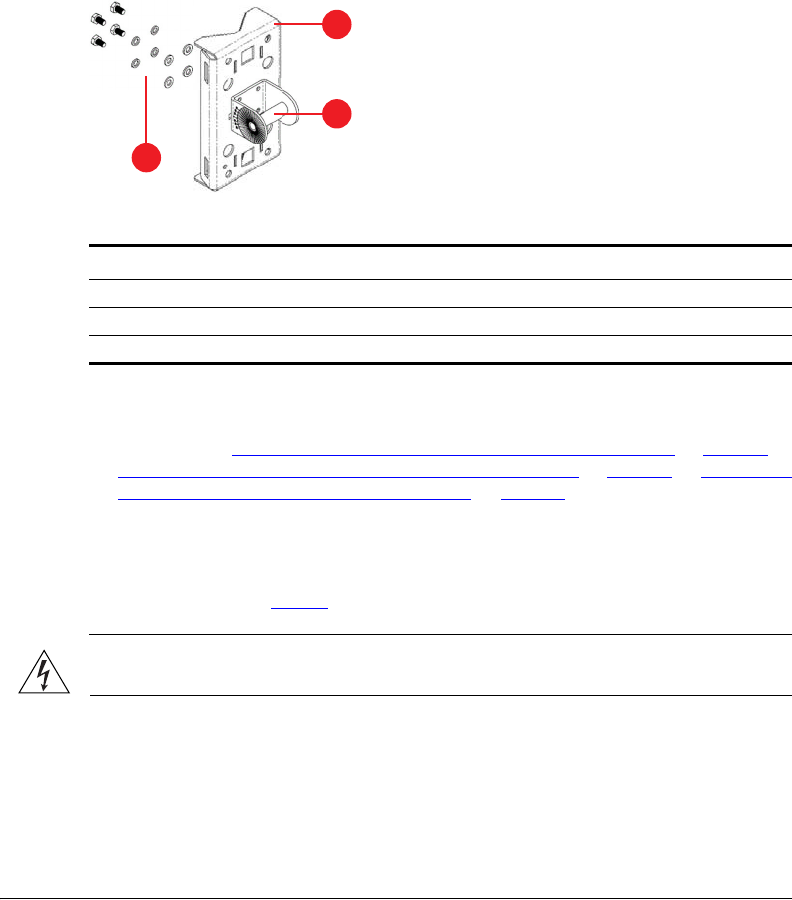
39
Installing the SC8800-S AP in the Field
Mounting the Access Point
Mounting the U-Joint Bracket to the M ain Mounting
Bracket
1. Position the U-joint bracket on the main mounting bracket. (Note the orientation.)
Figure 20. U-Joint Bracket Attached Horizontally to the Main Mounting Bracket
2. Use four small M6 bolt and washer sets to mount the U-joint bracket to the main
mounting bracket. Tighten the bolts to 9.5 N.m (7 ft-lbs).
3. Continue with “ Attaching the Main Mounting Bracket to a Flat Surface” on page 39 or
“ Attaching the Main Mounting Bracket to a Wooden Pole” on page 40, or “ Attaching
the Main Mounting Bracket to a Metal Pole” on page 42.
Attaching the Main Mounting Bracket to a Flat Surface
The main mounting bracket can be attached to a flat surface using small or large bolts or
screws as described in Tab l e 9.
WARNIN G: Ruckus Wireless strongly recommends that you wear eye protection before
drilling holes in the mounting surface.
1. Place the main mounting bracket at the location on the mounting surface where you
want to mount the AP.
2. Use the holes on the main mounting bracket as a template to mark the locations of
the mounting holes.
Table 10. Main Mounting Bracket and U-Joint Bracket
No. Description
1 Main Mounting Bracket
2 U-Joint Bracket
3 Small M6 Bolt and Washer Sets
1
2
3

40
Installing the SC8800-S AP in the Field
Mounting the Access Point
Figure 21. Flat Surface Mounting Hole Locations
3. Remove the main mounting bracket from the mounting surface.
4. Drill holes required for the mounting hardware (see Tab l e 9 for mounting hardware
options).
5. Attach the main mounting bracket to the flat surface using the mounting hardware.
Note the UP direction.
6. Using the mounting hardware instructions, tighten the hardware to secure the main
mounting bracket.
7. Continue with “ Mounting the Hook Bracket to the U-Joint Bracket” on page 43.
Attaching the Main Mounting Bracket to a Wooden Pole
The main mounting bracket can be attached to a wooden pole using carriage bolts as
described in Tab l e 9.
WARNIN G: Ruckus Wireless strongly recommends that you wear eye protection before
drilling holes in the pole.
1. Place the main mounting bracket at the location on the mounting surface where you
want to mount the AP.
2. Use the square holes on the main mounting bracket as a template to mark the locations
of the mounting holes.
Table 11. Main Mounting Bracket Flat Surface Holes
No. Interface Element Description
1 Large Holes (4 places) Designed for use with four customer-supplied 14mm (1/2“ )
bolts or screws.
2 Small Holes (4 places) Designed for use with four customer-supplied 6mm (1/4“ )
bolts or screws.
1
2
UP

41
Installing the SC8800-S AP in the Field
Mounting the Access Point
Figure 22. Wooden Pole Mounting Hole Locations
3. Remove the main mounting bracket from the pole.
4. Drill holes for the carriage bolts as required by the local pole owner.
5. Attach the main mounting bracket to the flat surface using the carriage bolts. Note the
UP direction.
6. Using carriage bolt nuts, tighten the carriage bolts as required by the local pole owner
to secure the main mounting bracket.
7. Continue with “ Mounting the Hook Bracket to the U-Joint Bracket” on page 43.
Table 12. Main Mounting Bracket Carriage Bolt Holes
No. Interface Element Description
1Square Holes
(2 places)
Designed for use with two customer-supplied M16 (5/8” )
carriage bolts.
1
UP
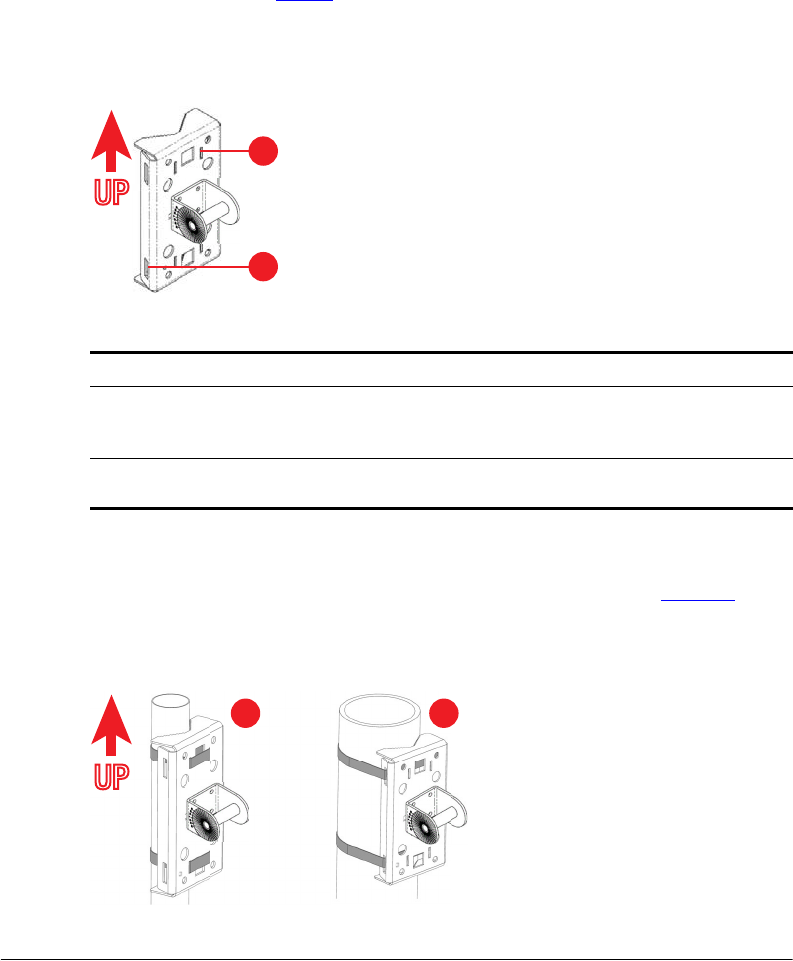
42
Installing the SC8800-S AP in the Field
Mounting the Access Point
Attaching the Main Mounting Bracket to a Metal Pole
The main mounting bracket can be attached to a metal pole using stainless steel adjustable
clamps as described in Tab l e 9.
1. Insert the open end of one steel clamp into the upper two slots on the main mounting
bracket.
Figure 23. Adjustable Clamp Slots for a Vertical Pole
2. Take the other steel clamp and insert it into the lower two slots on the main mounting
bracket.
3. Use the clamps to attach the main mounting bracket to the pole (see Figure 24). Note
the UP direction. Tighten the clamps to 1.1-1.2 N.m or 9.7-10.6 in-lbs, or per
manufacturer’s specifications.
Figure 24. Attaching the Main Mounting Bracket to a Vertical Pole
Table 13. Main Mounting Bracket Adjustable Clamp Slots
No. Interface Element Description
1 Small Slots (4 places) Designed for use with two or four factory-supplied 1/2”
(12.7mm) wide stainless steel adjustable clamps, 2.5”
(63.5mm) diameter, for smaller poles.
2 Large Slots (4 places) Designed for use with two customer-supplied 7/8” (22mm)
wide stainless steel adjustable clamps for larger poles.
1
2
UP
12
UP
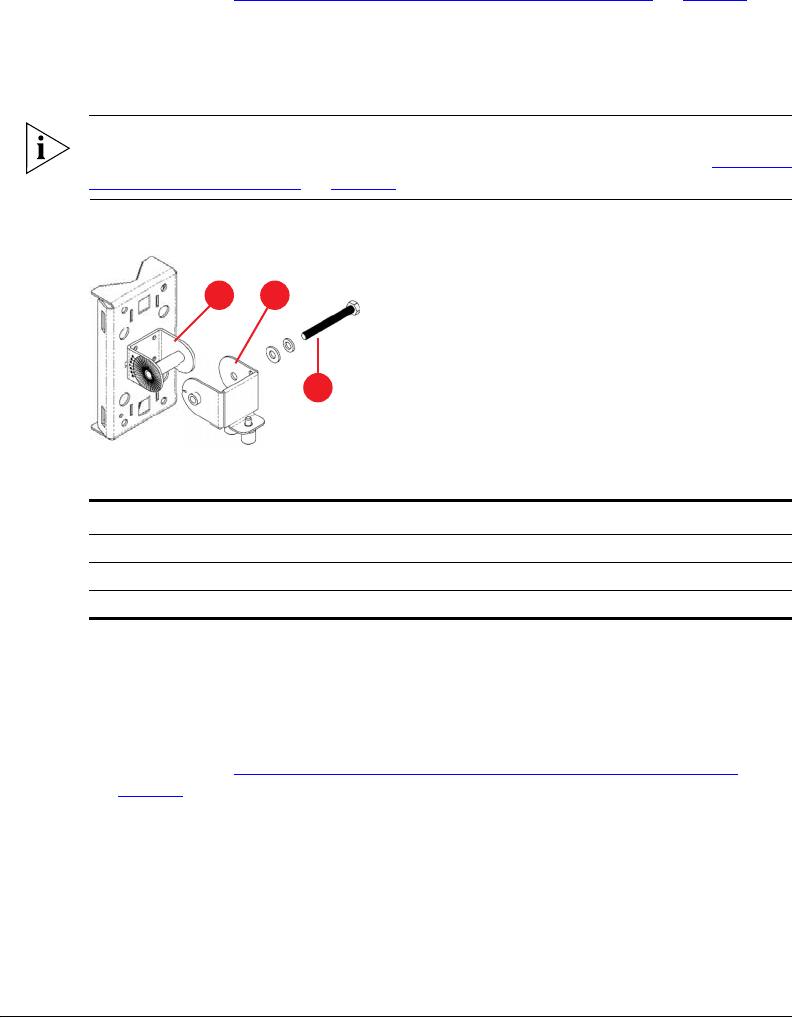
43
Installing the SC8800-S AP in the Field
Mounting the Access Point
4. Continue with “ Mounting the Hook Bracket to the U-Joint Bracket” on page 43.
Mounting the Hook Bracket to the U-Joint Bracket
The hook bracket attaches to the U-joint bracket using the large M8 bolt and washer set.
NOTE: The AP can be mounted outdoors in any orientation, as long as the internal GPS
antenna is pointed up or toward a mostly-unobstructed view of the sky. Refer to “ Pointing
the Internal GPS Antenna” on page 10.
Figure 25. Attaching the Hook Bracket to the U-Joint Bracket
1. Loosely assemble the hook bracket, the U-joint bracket, and the large M8 bolt and
washer set.
2. Set the elevation uptilt or downtilt required by the AP.
3. Tighten the large bolt to 27 N.m (20 ft-lbs).
4. Continue with “ Assembling the AP Attachment Bracket and the Access Point” on
page 44.
Table 14. Hook Bracket and U-Joint Bracket
No. Description
1 U-Joint Bracket
2 Hook Bracket
3 Large M8 Bolt and Washer Set
1 2
3
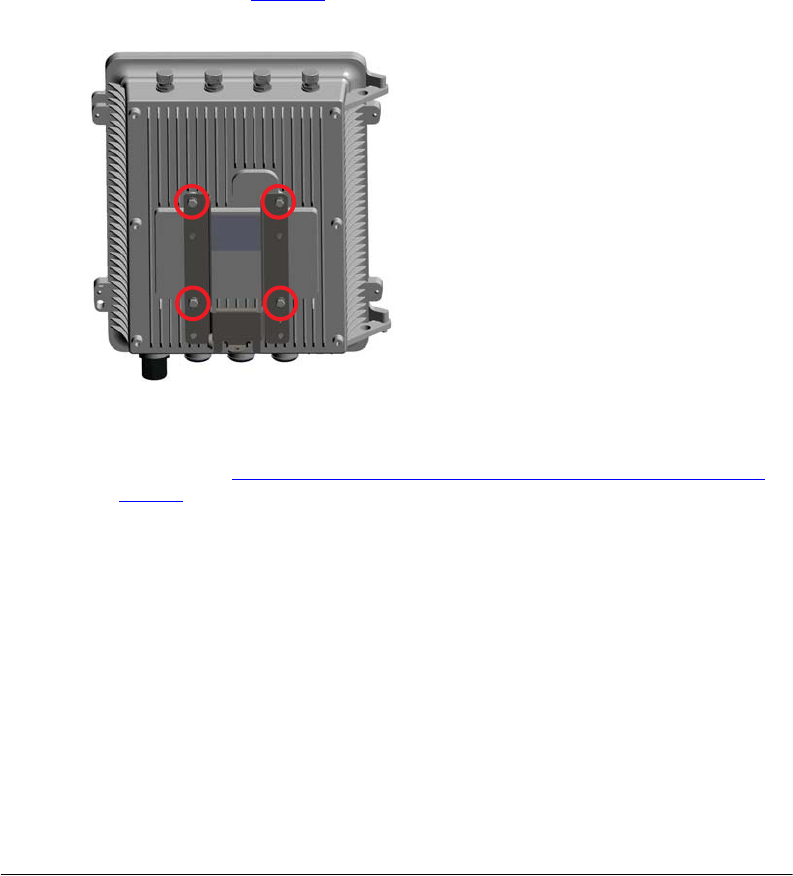
44
Installing the SC8800-S AP in the Field
Mounting the Access Point
Assembling the AP Attachment Bracket and the Access
Point
1. Place the AP attachment bracket onto the back side of the AP so that the four screw
holes on the bracket align with the four screw holes on the AP. Make sure that the
longer end of the AP attachment bracket is on the same side as the AP antenna
connectors. See Figure 26.
Figure 26. Attaching the AP Attachment Bracket to the AP
2. Use four small M6 bolt and washer sets to mount the AP attachment bracket to the AP.
Tighten the bolts to 9.5 N.m (7 ft-lbs).
3. Continue with “ Attaching the AP Attachment Bracket and AP to the Hook Bracket” on
page 45.
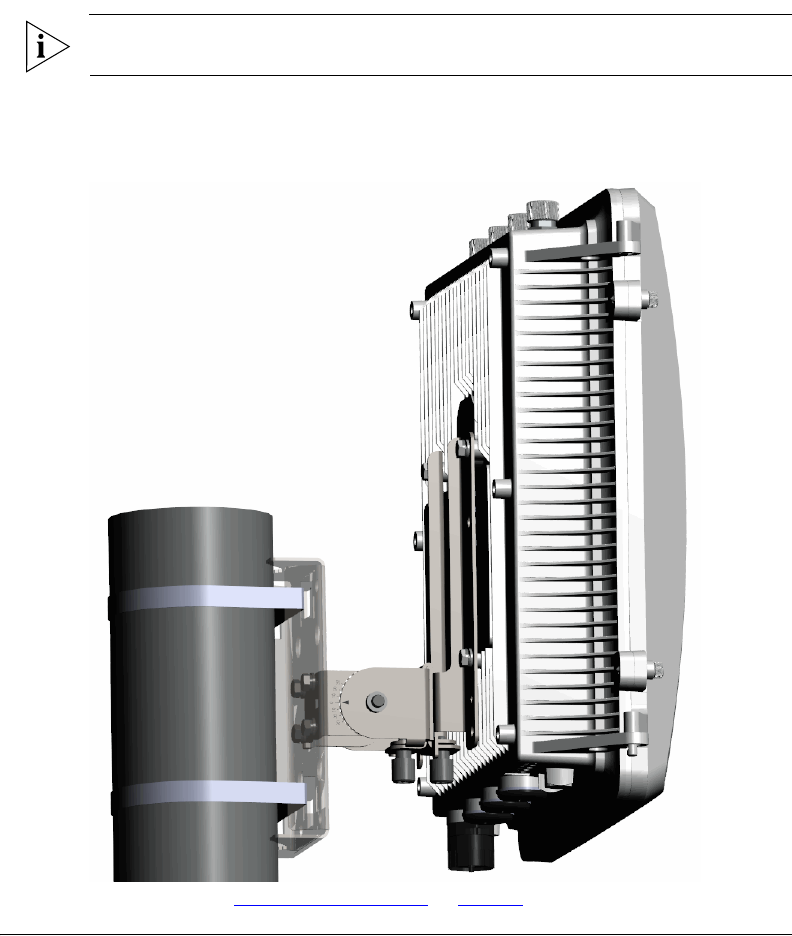
45
Installing the SC8800-S AP in the Field
Mounting the Access Point
Attaching the AP Attachment Bracket and AP to the Hook
Bracket
1. Slide the AP attachment bracket and AP assembly onto the hook bracket.
CAUTION: MAKE SURE that the AP attachment bracket slides securely onto the hook
bracket.
2. Finger-tighten the two hook bracket captive screws to secure the AP attachment
bracket and AP.
Figure 27. AP Attachment Bracket and AP Attached to the Hook Bracket
3. Continue with “ Safety-Cabling the AP” on page 46.

46
Installing the SC8800-S AP in the Field
Mounting the Access Point
Safety-Cabling the AP
1. Collect the 1/8” (3mm) diameter galvanized steel safety cable with loop on one end
and retaining washer on the eye end (24” , 610 mm).
2. Thread the safety cable around the main mounting bracket and thread the eye end
through the loop end as shown in Figure 28.
Figure 28. Secured safety cable
Table 15. Secured Safety Cable
No. Description
1 Main Mounting Bracket
2Safety Cable
3Eye End
1
2
3

47
Installing the SC8800-S AP in the Field
Mounting the Access Point
3. Use one small M6 bolt and washer set to attach the eye end of the safety cable to a
threaded boss on the back of the AP. Tighten the bolt to 9.5 N.m (7 ft-lbs).
Figure 29. Attaching the Safety Cable to the AP
You have mounted and safety-cabled the AP. If you are installing external antennas, then
continue with “ Mounting External Antennas (Optional)” on page 48. If you are not
installing an external antennas, then you have completed mounting the AP; continue with
“ Verifying Access Point Operation” on page 50.
Table 16. Safety Cable and AP
No. Description
1Safety Cable
2Eye End
3 SC8800-S Threaded Boss
1 2
3

48
Installing the SC8800-S AP in the Field
Mounting the Access Point
Mounting External Antennas (Optional)
NOTE: Mount internal and external antennas at least 20cm (7.9” ) away from each other.
You can connect one or two 5GHz external antennas to the 5GHz ANT0 and 5GHz ANT2
50-ohm N-type female connectors on the AP. You can also connect one or two 2.4GHz
external antennas to the 2.4 GHz ANT 2 and 2.4 GHz ANT 0 50-ohm N-type female
connectors on the AP.
In all cases, connecting external 5GHz antennas disables the internal AP 5GHz antennas,
and connecting external 2.4GHz antennas to the AP disables the internal AP 2.4GHz
antennas.
Refer to “ Appendix A: Ruckus Wireless-Supplied and Customer-Ordered Parts” on
page 61 for customer-ordered Ruckus Wireless external antennas. Refer to “ Planning the
SC8800-S AP Installation” on page 4 for typical external antenna coverage patterns.
WARNIN G: Only trained and qualified installers should be allowed to install, replace, or
service this equipment.
The professional installer is responsible for the proper installation and configuration of this
AP. The AP installation must comply with local regulatory requirements, especially with
those regulating operation near military and/or weather radar systems.
CAUTION: If you are not connecting external antennas to the AP, then make sure that the
metal caps remain installed and securely fastened to protect the interfaces from elements,
such as water and dirt.
1. Collect the external antenna(s), torque wrench and weatherproofing tape.
2. If the AP is powered, then disconnect the AP from the power source.
WARNIN G: MAKE SURE that you disconnect the AP from the power source to avoid
electrocution or equipment damage.
3. Unscrew the metal caps that protect the antenna connectors. Place the metal caps in
a safe place, in case you need them later.
4. Physically mount the antenna(s) at your desired location, preferably on the same
mounting structure as the AP.
5. Connect 5GHz antenna(s) to the 5GHz ANT0 and 5GHz ANT2 50-ohm N-type female
antenna connectors on the AP.
6. Connect 2.4GHz antennas to the 2.4 GHz ANT 2 and 2.4 GHz ANT 0 50-ohm N-type
female antenna connectors on the AP.

49
Installing the SC8800-S AP in the Field
Mounting the Access Point
7. Use a torque wrench to tighten the connectors to 1.58 N.m (14 in-lbs).
If you do not have a torque wrench, then hand-tighten the connectors until the internal
washers are compressed, but do not overtighten.
8. Apply weatherproofing tape to the antenna connectors to help prevent water and dirt
from entering the AP.
You have completed connecting external antennas to the AP. Continue with “ Verifying
Access Point Operation” on page 50.

50
Installing the SC8800-S AP in the Field
Verifying Access Point Operation
Verifying Access Point Operation
After mounting the AP, Ruckus Wireless strongly recommends that you verify that the AP
is operating correctly. To do this, you will need to do the following:
■Powering the AP
■Connecting the AP to the Network
■Configuring the External Antenna Gain
■Associating a Wireless Client with the AP
■Checking the TR069 Status (FlexMaster Management only)
Powering the AP
Refer to the following:
■“ Powering Options” on page 50
■“ Powering the AP with AC” on page 51
■“ Powering the Access Point with PoE” on page 52
■“ Checking the LED Operation” on page 52
Powering Options
The connections required for your installation depend on the power source that you are
using.
Figure 15 shows an example of the connections required for a typical outdoor PoE
installation. Figure 16 shows an example of the connections required for a typical outdoor
AC installation. Note which components must be installed indoors and outdoors.
Ruckus Wireless strongly recommends 80mm - 130mm (3” -5” ) drip loops on any cables
that are installed outdoors.
NOTE: The AP only requires one power source (either AC or PoE), but can be powered
by AC and PoE at the same time.
- The AP can be powered by 60W PoE to support 802.3af PoE Out to 15.4W.
- The AP can be powered by 60W PoE to support 802.3at PoE Out to 27W. 802.3at (25.5W)
PoE can be supported with 20m (65.6 ft.) or shorter CAT5e UTP or better cable.
- When AC powered and PoE is present, the AP draws power from the AC connection.
WARNIN G: When the AP is powered by AC and installed in a damp or wet location, the
AC branch circuit should be protected with a Residual-Current Circuit Breaker (RCCB), also
known as a Ground Fault Circuit Interrupter (GFCI), per National Electrical Code
Article 210.

51
Installing the SC8800-S AP in the Field
Verifying Access Point Operation
Powering the AP with AC
1. Collect required tools and supplies:
• An outdoor-rated three-wire (1-2mm2 or 14-18AWG) AC cable long enough to
connect the AP with the AC power source.
• A wire stripper.
• A pair of long-nose pliers.
• A small screwdriver.
• A ruler (for measuring the stripped portion of the AC cable).
2. Remove the small plastic bag that contains the AC cable connector from the AP
package.
3. Separate the AC cable connector parts by unscrewing the boot from the cable gland
and the cable gland from the connector housing. See Figure 18.
4. Feed the end of the AC cable through the boot and cable gland.
5. Strip the AC cable as shown in Figure 18.
6. Insert the stripped part of the conductors into the appropriate terminals on the
connector housing. The conductors are color-coded and must be connected to the
appropriate terminals as shown in Figure 18. See Tab l e 17 for typical AC wire colors.
7. Using a small screwdriver, tighten the small screws around the connector housing to
fix the connector pins into the terminals.
8. Mate the cable gland with the connector housing, and then tighten.
NOTE: Two different-sized grommets are supplied in the AC connector assembly kit. Use
the grommet that is appropriate to the diameter of the AC cable that you are using.
9. Mate the boot with the cable gland, and then tighten to seal.
10. Connect the AC cord connector that you have assembled to the AC power socket on
the AP.
11. Connect the AC cord to an AC power source.
Table 17. Typical AC wire colors
Terminal Color
(Earth Ground) Green (US), Green/Yellow (EU)
1 (Neutral/Return) White or Gray (US), Blue (EU)
2 (Line/Hot) Black (US), Brown (EU)
3 (not used)
Note: The color coding of wire conductors varies by region. Before completing this step,
check your local wiring standards for guidance.

52
Installing the SC8800-S AP in the Field
Verifying Access Point Operation
12. Check the PWR LED. Initially, the LED turns red as the AP powers on. After it completes
the power-on sequence, the LED turns green.
NOTE: If the PWR LED does not turn on at all, one or both of the AC power supply fuses
inside the SC8800-S chassis may have burned out. Open the SC8800-S cover and replace
any burned-out 5A, 250V, slow-blow fuse(s), as required.
13. You have completed connecting the AP to an AC power source. Continue with
“ Checking the LED Operation” on page 52.
Powering the Access Point with PoE
1. Obtain a Ruckus Wireless 60W PoE injector. (Refer to “ Appendix A: Ruckus Wireless-
Supplied and Customer-Ordered Parts” on page 61 to order a Ruckus Wireless 60W
PoE injector.)
2. Obtain one Cat5e or better Ethernet cable.
3. Connect one end of one Ethernet cable to the Data Out/ Power Out port on the PoE
injector, and then connect the other end to the PoE IN port on the AP.
4. Connect the PoE injector to a power source.
5. Check the PWR LED. Initially, the LED turns red as the AP powers on. After it completes
the power-on sequence, the LED turns green.
6. You have completed connecting the AP to a PoE power source. Continue with
“ Checking the LED Operation” on page 52.
Checking the LED Operation
■Perform a spot-check using the LEDs to verify that the AP is operating normally. When
the AP is operating normally and no wireless clients are associated with it:
• The PWR LED is green.
• The 2.4G and 5G LEDs show slow blinking amber. This indicates that there are no
wireless clients connected to the AP’s WLAN services.
You have checked the LED operation. Continue with “ Connecting the AP to the Network”
on page 53.

53
Installing the SC8800-S AP in the Field
Verifying Access Point Operation
Connecting the AP to the Network
The AP can connect to the network using data cables, or can connect to the network using
wireless backhaul if it is part of a mesh network.
NOTE: If the ZoneDirector is set to Enable Mesh, ZoneDirector automatically assigned
the AP as a Root AP while “ Configuring the AP for Management by ZoneDirector” on
page 15.
1. If the AP is part of a mesh network, continue with Step 2. If the AP is using AC power,
then continue with Step 4. If the AP is using PoE, then continue with Step 6.
2. When the AP has been configured as Root AP, and is powered up and does not find a
wired connection back to its ZoneDirector, it automatically looks for another Root AP.
When it finds another AP in the mesh network, it automatically provisions itself as a
Mesh AP in the mesh network.
3. Continue with “ Configuring the External Antenna Gain” on page 54 or “ Associating a
Wireless Client with the AP” on page 59.
4. Connect the Ethernet cable from your network’s router or switch to the PoE IN port on
the AP.
5. Continue with “ Configuring the External Antenna Gain” on page 54 or “ Associating a
Wireless Client with the AP” on page 59.
6. Connect the Ethernet cable from the Data In port on the PoE injector to your network’s
router or switch.
7. Continue with “ Configuring the External Antenna Gain” on page 54 or “ Associating a
Wireless Client with the AP” on page 59.

54
Installing the SC8800-S AP in the Field
Verifying Access Point Operation
Configuring the External Antenna Gain
You can configure the maximum gain for each set of 5GHz and 2.4GHz external antennas
connected to the AP (“ Mounting External Antennas (Optional)” on page 48). Refer to the
following to set the maximum gains:
■“ Configuring 5GHz External Antenna Gain” on page 54
■“ Configuring 2.4GHz External Antenna Gain” on page 57
Configuring 5GHz External Antenna Gain
The AP allows you to configure the gain of up to two customer-supplied 5GHz external
antennas. The maximum value for the antenna gain depends on the type of external
antennas that you are connecting to the AP. Refer to Tab l e 18 for the recommended
antenna gain values that you can use for different 5GHz antenna types.
There are three ways you can configure the gain for the 5GHz antennas:
■Configuring the 5GHz Ante nna Gain from the AP Web Inte rface
■Configuring the 5GHz Ante nna Gain from the AP CLI
■Configuring the 5GHz Antenna Gain from the Zo ne Director Web Inte rface
Configuring the 5GHz Antenna Gain from the AP Web Interface
1. If not already done, log in to the AP web interface as described in “ Logging In to the
Access Point’s Web Interface” on page 19.
2. On the left menu of the web interface, click Configuration > Radio 5G. The Common
page appears.
Table 18. Antenna gain values for different 5GHz antenna types
Antenna Type 5GHz Antenna Gain Value
Omni Antenna 6dBi or lower
Sector Antenna 12.5dBi or lower
Point-to-Point Antenna 24dBi or lower
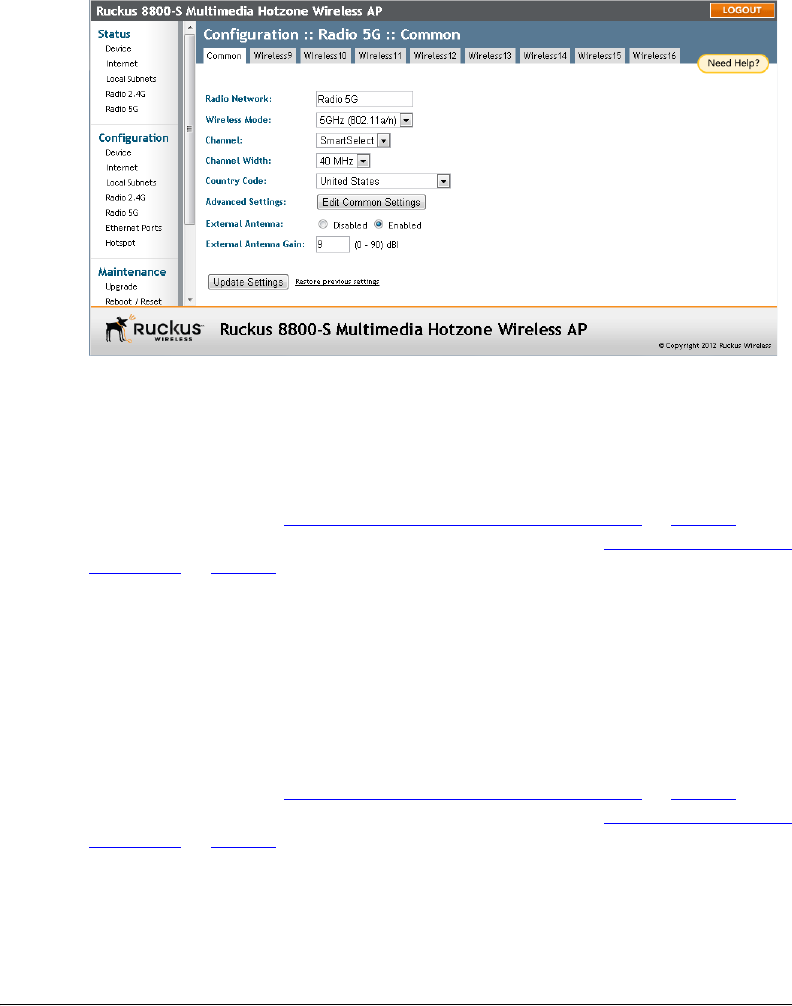
55
Installing the SC8800-S AP in the Field
Verifying Access Point Operation
Figure 30. Configure the external 5GHz antenna gain - AP web interface
3. In External Antenna, click Enabled.
4. In External Antenna Gain, enter the antenna gain value (in dBi).
5. If you made any changes to the Common tab, then click Update Settings.
You have configured the 5GHz antenna gain. If you are also configuring the 2.4GHz antenna
gain, then continue with “ Configuring 2.4GHz External Antenna Gain” on page 57. If you
are not configuring the 2.4GHz antenna gain, then continue with “ Verifying Access Point
Operation” on page 50.
Configuring the 5GHz Antenna Gain from the AP CLI
1. Log in to the AP command line interface.
2. Set the 5GHz antenna gain by entering the following command:
set extantgain wifi1 <0 - 90dBi>
3. Verify that the antenna gain has been configured by entering the following command:
get extantgain wifi1
You have configured the 5GHz antenna gain. If you are also configuring the 2.4GHz antenna
gain, then continue with “ Configuring 2.4GHz External Antenna Gain” on page 57. If you
are not configuring the 2.4GHz antenna gain, then continue with “ Verifying Access Point
Operation” on page 50.
Configuring the 5GHz Antenna Gain from the ZoneDirector Web Interface
1. Log in to the web interface of the ZoneDirector device that is managing the AP.
2. Go to the Configure > Access Point Groups page.

56
Installing the SC8800-S AP in the Field
Verifying Access Point Operation
3. In the Model Specific Control parameter, select ZoneFlex AP. ZoneDirector displays
the External Antenna entries.
Figure 31. Configure the 5GHz antenna gain - ZoneDirector
4. In the External Antenna section:
• Select the External Antenna checkbox.
• Enter the external antenna gain in dBi for the 5GHz antenna(s).
5. Click OK at the bottom of the form to save your changes.
You have configured the 5GHz antenna gain. If you are also configuring the 2.4GHz antenna
gain, then continue with “ Configuring 2.4GHz External Antenna Gain” on page 57. If you
are not configuring the 2.4GHz antenna gain, then continue with “ Verifying Access Point
Operation” on page 50.

57
Installing the SC8800-S AP in the Field
Verifying Access Point Operation
Configuring 2.4GHz External Antenna Gain
The AP allows you to configure the gain of up to two customer-supplied 2.4GHz external
antennas. The maximum value for the antenna gain that you should set depends on the
type of external antennas that you are connecting to the AP. Refer to Tab l e 19 for the
recommended antenna gain values that you can use for different antenna types.
There are three ways you can configure the gain for the 2.4GHz antennas:
■Configuring the 2.4GHz Ante nna Gain from the AP Web Interface
■Configuring the 2.4GHz Ante nna Gain from the AP CLI
■Configuring the 2.4GHz Ante nna Gain from the ZoneDirector Web Inte rface
Configuring the 2.4GHz Antenna Gain from the AP Web Interface
1. If not already done, log in to the AP web interface as described in “ Logging In to the
Access Point’s Web Interface” on page 19.
2. On the left menu of the web interface, click Configuration > Radio 2.4G. The Common
page appears.
Figure 32. Configure the external 2.4GHz antenna gain - AP web interface
3. In External Antenna, click Enabled.
4. In External Antenna Gain, enter the antenna gain value (in dBi).
Table 19. Antenna gain values for different 2.4GHz antenna types
Antenna Type 2.4GHz Antenna Gain Value
Omni Antenna 5dBi or lower
Sector Antenna 19dBi or lower

58
Installing the SC8800-S AP in the Field
Verifying Access Point Operation
5. If you made any changes to the Common tab, click Update Settings.
You have configured the 2.4GHz antenna gain. Continue with “ Associating a Wireless
Client with the AP” on page 59.
Configuring the 2.4GHz Antenna Gain from the AP CLI
1. Log in to the AP command line interface.
2. Set the 2.4GHz antenna gain by entering the following command:
set extantgain wifi0 <0 - 90dBi>
3. Verify that the antenna gain has been configured by entering the following command:
get extantgain wifi0
You have configured the 2.4GHz antenna gain. Continue with “ Associating a Wireless
Client with the AP” on page 59.
Configuring the 2.4GHz Antenna Gain from the ZoneDirector Web Interface
1. Log in to the web interface of the ZoneDirector device that is managing the AP.
2. Go to the Configure > Access Point Groups page.
3. In the Model Specific Control parameter, select ZoneFlex AP. ZoneDirector displays
the External Antenna entries.
4. In the External Antenna section:
• Select the External Antenna checkbox.
• Enter the external antenna gain in dBi for the 2.4GHz antenna(s).
5. Click OK at the bottom of the form to save your changes.
You have configured the 2.4GHz antenna gain. Continue with “ Associating a Wireless
Client with the AP” on page 59.

59
Installing the SC8800-S AP in the Field
Verifying Access Point Operation
Associating a Wireless Client with the AP
1. In the client device's wireless interface, select the SSID configured in the “ Configuring
Wireless # Settings” on page 22 section.
2. Connect the client device to the selected WLAN SSID.
3. After the wireless client successfully connects to the wireless LAN, continue with
“ Checking the TR069 Status (FlexMaster Management only)” on page 59 or “ What to
Do Next” on page 60.
Checking the TR069 Status (FlexMaster M anagement
only)
If you configured the AP to report to a FlexMaster server on the network, then make sure
you verify that it can successfully communicate with the FlexMaster server. You can do this
by checking the TR069 status on the AP’s web interface.
1. If not already done, log in to the AP’s web interface as described in “ Logging In to the
Access Point’s Web Interface” on page 19.
2. Go to the Administration > Management page.
3. Scroll down to the TR069 Status section.
4. Check the value for Last successful contact. If it shows a date in green, this indicates
that the AP was able to communicate successfully with FlexMaster.
You have installed the AP in the field. Continue with “ What to Do Next” on page 60.

60
What to Do Next
Changing the Administrative Password
5What to Do Next
The following are some of the post-installation tasks that Ruckus Wireless recommends.
Refer to the ZoneFlex Outdoor Access Point User Guide for more information on config-
uring and managing the AP.
Changing the Administrative Password
Management access to the web interface of the AP is controlled through administrative
user name and password. As soon as you complete the AP setup, make sure you log on
to the AP’s web interface and change the default administrative user name and password.
This will help prevent unauthorized users from logging in to the AP’s web interface and
changing the AP settings to compromise your network.
Configuring the Security Settings
Unlike wired networks, anyone with a compatible wireless adapter can receive wireless
data transmissions from your network well beyond your walls. To prevent unauthorized
users from entering your wireless network and accessing your computers and files, Ruckus
Wireless strongly recommends enabling and configuring wireless security on the AP. The
AP supports several types of encryption and authentication methods to help prevent
unauthorized access to your wireless network.
Configuring Advanced Settings and Features
The AP has been configured for basic operation. However, the Ruckus Wireless AP
supports many advanced settings and features. Refer to the ZoneFlex Outdoor Access
Point User Guide, ZoneDirector User Guide, or FlexMaster User Guide for instructions on
how to configure the advanced setting and feature parameters.
Reading Related Documentation
If you are using FlexMaster or ZoneDirector to manage the AP, make sure you read the
accompanying documentation to learn how to configure and manage the AP from the
FlexMaster and ZoneDirector web interface.
The latest versions of Ruckus Wireless product documentation are available for download
on the Ruckus Wireless Support Web site at
http://support.ruckuswireless.com/documents

61
Appendix A: Ruckus Wireless-Supplied and
Customer-Ordered Parts
Table 20. Ruckus Wireless- and customer-supplied parts
Part Ruckus
Wireless
P/ N
Factory Kit
or
Customer
Ordered
Notes
Main Mounting Bracket
(1 piece)
-- Factory AP
Mounting
Kit
U-Joint Bracket
(1 piece)
-- Factory AP
Mounting
Kit
Small M6 Bolt and Washer Sets-
-M6 hex bolt, 10mm, M6 x 1 with
lock and flat washers
(9 sets)
-- Factory AP
Mounting
Kit
Stainless
steel
Hook Bracket
(1 piece)
-- Factory AP
Mounting
Kit
Large M8 Bolt and Washer Set
--M8 hex bolt, 70mm, M8x1.25,
with lock and flat washers
(1 set)
-- Factory AP
Mounting
Kit
Stainless
steel
AP Attachment Bracket
(1 piece)
-- Factory AP
Mounting
Kit

62
1/2” (12.7mm) wide stainless
steel adjustable clamps, 2.5-
inch (63.5mm) diameter
(4 pieces)
-- Factory AP
Mounting
Kit
Stainless
steel
M 25 waterproof ethernet cable
gland
(2 pieces)
902-0183-
0000
Factory AP
Small Parts
Kit
AC cable connector
(1 piece)
902-0185-
0000
Factory AP
Small Parts
Kit
Safety Cable Kit 902-0115-
0000
Factory AP
Small Parts
Kit
Ruckus Wireless 60W PoE
injector (optional)
902-0180-
XX00,
where XX is
the country
code
Optionally
customer-
ordered
Only if PoE
is used
Country-specific 3-wire AC
power cable with an IEC C13
plug on the PoE injector end
-- Customer-
supplied
Only if AC is
used
Table 21. Orderable 2.4GHz Antennas
Part Ruckus
Wireless
P/ N
Notes
2.4GHz 5dBi V External Omni Outdoor
Antenna
911-0005-
VP01
Kit includes
one
vertically-
polarized
antenna
Table 20. Ruckus Wireless- and customer-supplied parts (Continued)
Part Ruckus
Wireless
P/ N
Factory Kit
or
Customer
Ordered
Notes

63
2.4GHz 6dBi H External Omni Outdoor
Antenna
911-0006-
HP01
Kit includes
one
horizontally
-polarized
antenna
Table 22. Orderable 5GHz Antennas
Part Ruckus
Wireless
P/ N
Notes
5GHz 12dBi
120-degree 2x2 Dual-Polarized Sector
Outdoor Antenna
911-1212-
DP01
--
5GHz 21dBi Point-to-Point 2x2 Dual-
Polarized Directional Outdoor Antenna
911-2101-
DP01
--
5GHz 24dBi Point-to-Point 2x2 Dual-
Polarized Directional Outdoor Antenna
911-2401-
DP01
--
5GHz 5.5dBi V External Omni Outdoor
Antenna
911-0636-
VP01
Kit includes
one
vertically-
polarized
antenna
Table 21. Orderable 2.4GHz Antennas (Continued)
Part Ruckus
Wireless
P/ N
Notes

64
5GHz 5dBi H External Omni Outdoor
Antenna
911-0536-
HP01
Kit includes
one
horizontally-
polarized
antenna
5GHz 5dBi H and V External Omni
Outdoor Antennas
911-0636-
VH01
Kit includes
one
vertically-
and one
horizontally-
polarized
antennas
Table 22. Orderable 5GHz Antennas (Continued)
Part Ruckus
Wireless
P/ N
Notes
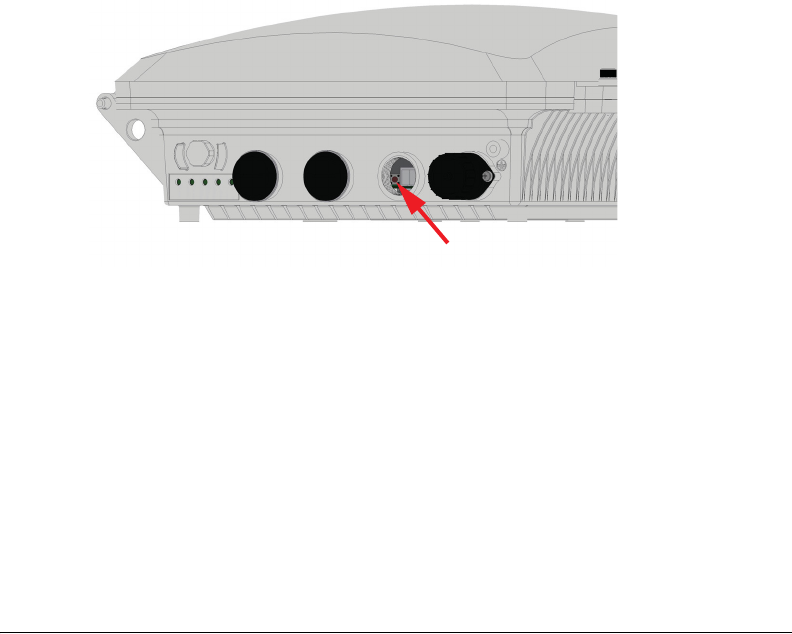
65
Appendix B: Resetting the Access Point to
Factory Default Settings
You can reset the AP to its factory default settings by pressing the reset button located
inside the PoE OUT/RESET port.
1. Remove the PoE OUT/RESET blanking cap or cable gland.
2. Make sure that the AP is powered.
3. Locate the reset button inside the PoE OUT/RESET port.
4. Using a pen or a similar pointed object, press the button for 10 seconds. The PWR LED
turns red.
5. After the AP reboots, verify that the PWR LED is solid green. When the PWR LED is
solid green, it indicates that the reset process is complete.
You have completed resetting the AP to its factory default settings.
Figure 33. Location of the reset button
Reset Button
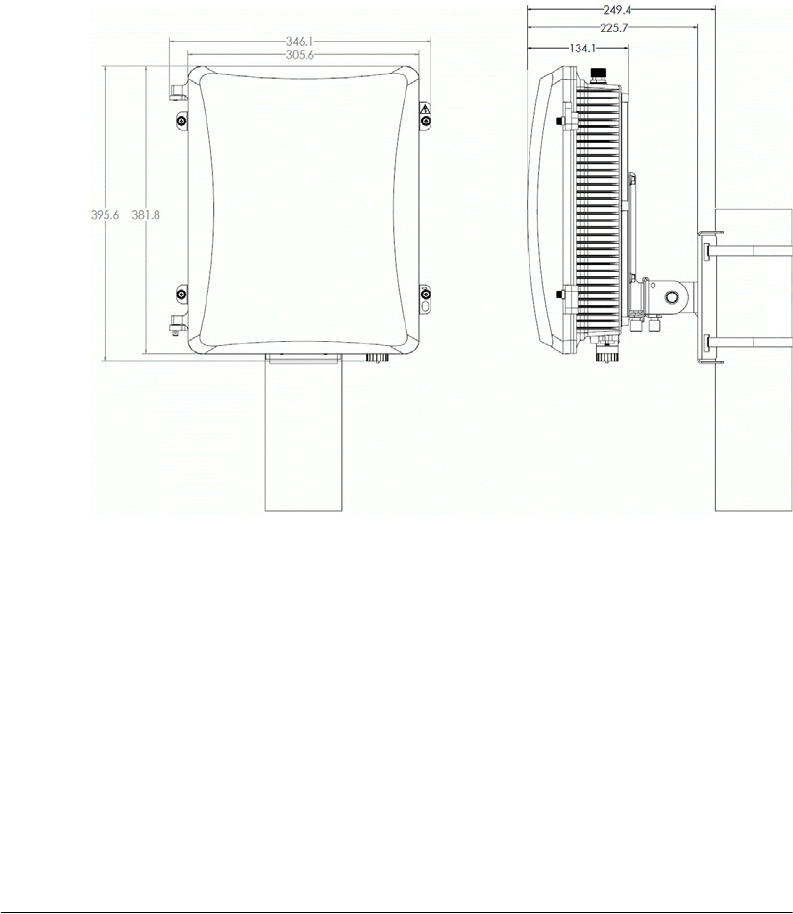
66
Appendix C: Installer Mounting Dimensions
All dimensions are in millimeters.
Figure 34. SC8800-S dimensions

67

68 Ruckus Wireless, Inc.

69

Copyright © 2006-2013. Ruckus Wireless, Inc.
350 West Java Dr. Sunnyvale, CA 94089. USA
www.ruckuswireless.com

